Home » Incredible PBX (Page 27)
Category Archives: Incredible PBX
Sneak Peek: Incredible PBX with FreePBX 13 GPL Modules
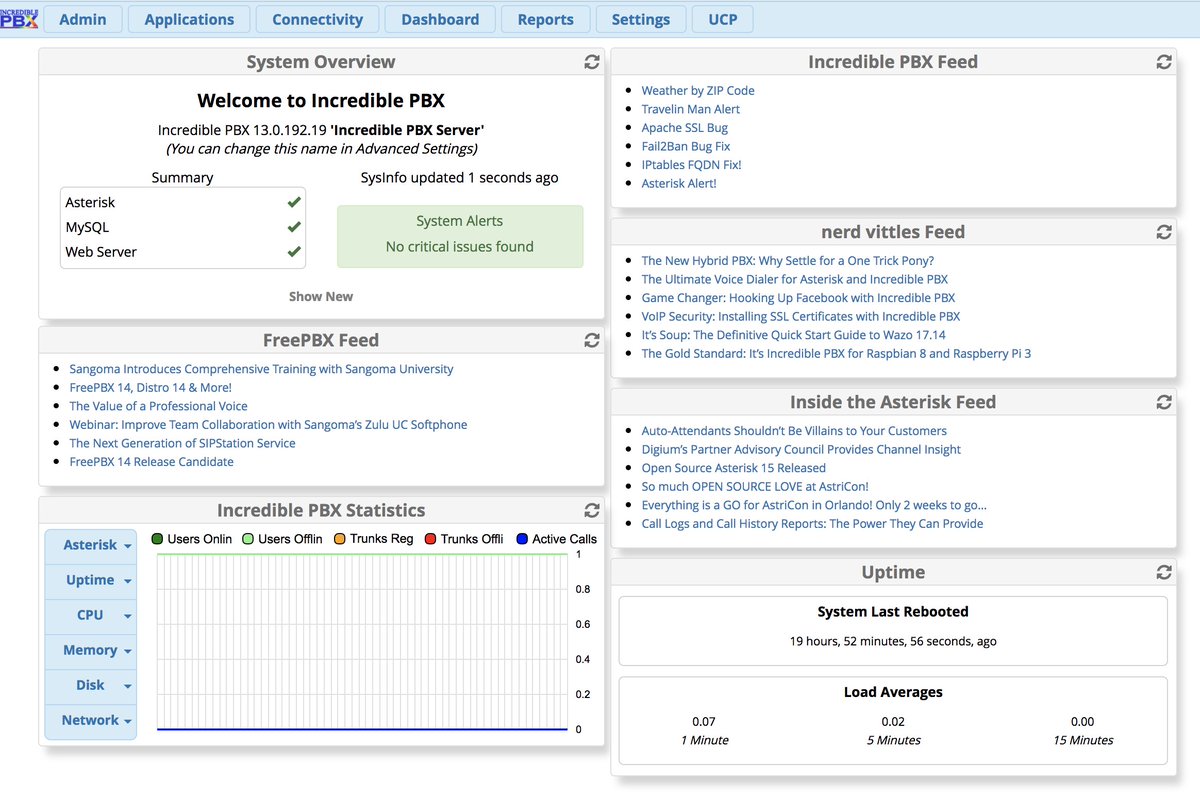
[iframe-popup id="4″]
As many of you know, the Asterisk® 13.16 and 13.17 releases caused serious breakage with FreePBX® 12 GPL deployments. These have been resolved in the new Asterisk 13.18 release candidate, but it prompted us to do a little exploring for alternatives while many of you were partying at AstriCon in Orlando last week. To give credit where credit is due, the Sangoma developers have made some impressive improvements with their FreePBX 13 release. And now we’re pleased to introduce a preview of the new Incredible PBX 13-13 platform featuring almost all of the FreePBX 13 GPL modules. For those that prefer lean and mean implementations of Asterisk, this preview edition is for you. You get the latest version of Asterisk compiled from source, and you get a base install of the FreePBX 13 GPL modules. The only preconfigured component in the build is the Travelin’ Man 3 firewall which locks down your server to trusted providers and IP addresses which you authorize.
We would hasten to add that Incredible PBX 13-13 is still a work in progress. Changes and improvements are released almost daily. If you don’t have that pioneering spirit, then you may wish to hold off for a few more weeks until all of the kinks have been worked out. Having said that, part of the fun of participating in the open source community is rolling up your sleeves and trying out new things. Offering your suggestions as we move along almost always yields a better end product both for you and the rest of the open source community. While we don’t ordinarily recommend deployment of preview editions for production systems, it’s worth noting that both Asterisk 13 and FreePBX 13 have a lot of miles on them and are generally regarded as the production-ready platforms for serious deployments.
So let’s get started. You can install Incredible PBX 13-13 Lean on a dedicated server, on a virtual machine platform such as VirtualBox, or a Cloud-based server such as Vultr. We recommend a minimum 1GB of RAM although you can get away with 512MB of RAM if you also create a swapfile. We’ve provided a script to do it for you. Depending upon the number of users your server will be supporting, we recommend a disk capacity of 10-30 GB. Last but not least, you need a reliable Internet connection.
Before you can install Incredible PBX 13-13 Lean, you’ll need a basic Linux platform. For this build, you can start by deploying a minimal install of CentOS 6 or 7. The Incredible PBX installer will load all of the necessary components to support Asterisk and FreePBX as well as future Incredible PBX applications.
Installing a Base CentOS Operating System
Let’s begin by installing 64-bit CentOS 6.9 or 7 on your favorite hardware or Desktop. Or you may prefer to use a Cloud provider1 that already offers a preconfigured CentOS image. Two reasons we prefer Vultr are (1) Incredible PBX runs fine on their least costly $2.50/mo. platform and (2) for an extra 50 cents a month, you can add automatic backups to your server platform. In you’re using a Cloud platform, you can skip the rest of this section. Just choose CentOS 6 or 7 as the default operating system for your cloud-based server.
For those using a dedicated hardware platform or wishing to install CentOS as a virtual machine, the drill is the same. Start by downloading the 64-bit CentOS 6.9 minimal ISO or the CentOS 7 minimal ISO. Burn the ISO to a DVD unless you’ll be booting from the ISO on a virtual machine platform such as VirtualBox. On virtual platforms, we recommend at least 1GB RAM and a 20GB dedicated drive. For VirtualBox, here are the settings:
Type: Linux
Version: RedHat 64-bit
RAM: 1024MB
Default Drive Options with 10GB+ space
Create
Settings->System: Enable IO APIC and Disable HW Clock (leave rest alone)
Settings->Audio: Enable
Settings->Network: Enable, Bridged
Settings->Storage: Far right CD icon (choose your ISO)
Start
Boot your server with the ISO, and start the CentOS install. Here are the simplest installation steps:
Choose Language and Click Continue
Click: Install Destination (do not change anything!)
Click: Done
Click: Network & Hostname
Click: ON
Click: Done
Click: Begin Installation
Click: Root Password: password, password, Click Done twice
Wait for Minimal Software Install and Setup to finish
Click: Reboot
Installing Incredible PBX 13-13 Lean Preview
Once you have CentOS up and running, log into your server as root and issue the following commands to kick off the Incredible PBX install. It’s a two-step process. First, the installer will bring your version of CentOS up to current specs and load the necessary packages to support Asterisk and FreePBX. The first stage setup takes about 10-15 minutes.
cd /root yum -y install net-tools nano wget tar wget http://incrediblepbx.com/incrediblepbx-13-13-LEAN.tar.gz tar zxvf incrediblepbx-13-13-LEAN.tar.gz rm -f incrediblepbx-13-13-LEAN.tar.gz ./create-swapfile-DO ./IncrediblePBX-13-13.sh
When the base install finishes, your server will reboot. Simply log back in as root and run the installer a second time using an SSH terminal or Putty. You’ll be prompted whether to implement Google Voice plain text or OAuth 2 passwords. OAuth is strongly recommended. Make your selection, and the installer will work its magic. Come back in 15 minutes.
./IncrediblePBX-13-13.sh
Reboot one final time when the installer finishes the setup, and your server should be ready to go. Log back in as root. This will kick off the Automatic Update Utility to load any last minute additions, bug fixes, and security patches. After the status menu displays, run the following apps to set a very secure admin password for web access to the GUI and to choose your default time zone:
/root/admin-pw-change /root/timezone-setup
WebMin is also installed and configured as part of the base install. The root password for access is the same as your Linux root password. We strongly recommend that you not use WebMin to make configuration changes to your server. You may inadvertently damage the operation of your server beyond repair. WebMin is an excellent tool to LOOK at how your server is configured. When used for that purpose, we highly recommend WebMin as a way to become familiar with your Linux configuration.
Using the Incredible PBX 13-13 Web GUI
Most of the configuration of your PBX will be performed using the web-based Incredible PBX GUI with its FreePBX 13 GPL modules. Use a browser pointed to the IP address of your server and choose Incredible PBX Admin. Log in as admin with the password you configured in the previous step. HINT: You can always change it if you happen to forget it.

To get a basic system set up so that you can make and receive calls, you’ll need to add a VoIP trunk, create one or more extensions, set up an inbound route to send incoming calls to an extension, and set up an outbound route to send calls placed from your extension to a VoIP trunk that connects to telephones in the real world. You’ll also need a SIP phone or softphone to use as an extension on your PBX. Our previous tutorial will walk you through this setup procedure. Over the years, we’ve built a number of command line utilities including a script to preconfigure SIP trunks for more than a dozen providers in seconds. You’ll find links to all of them here. Come join the discussion on the PIAF Forum and enjoy the ride!
Now Serving: The Incredible PBX 13-13 Whole Enchilada Upgrade
Continue Reading: Configuring Extensions, Trunks & Routes
Published: Monday, October 23, 2017

Need help with Asterisk? Visit the PBX in a Flash Forum.
Special Thanks to Our Generous Sponsors
FULL DISCLOSURE: ClearlyIP, Skyetel, Vitelity, DigitalOcean, Vultr, VoIP.ms, 3CX, Sangoma, TelecomsXchange and VitalPBX have provided financial support to Nerd Vittles and our open source projects through advertising, referral revenue, and/or merchandise. As an Amazon Associate and Best Buy Affiliate, we also earn from qualifying purchases. We’ve chosen these providers not the other way around. Our decisions are based upon their corporate reputation and the quality of their offerings and pricing. Our recommendations regarding technology are reached without regard to financial compensation except in situations in which comparable products at comparable pricing are available from multiple sources. In this limited case, we support our sponsors because our sponsors support us.
 BOGO Bonaza: Enjoy state-of-the-art VoIP service with a $10 credit and half-price SIP service on up to $500 of Skyetel trunking with free number porting when you fund your Skyetel account. No limits on number of simultaneous calls. Quadruple data center redundancy. $25 monthly minimum spend required. Tutorial and sign up details are here.
BOGO Bonaza: Enjoy state-of-the-art VoIP service with a $10 credit and half-price SIP service on up to $500 of Skyetel trunking with free number porting when you fund your Skyetel account. No limits on number of simultaneous calls. Quadruple data center redundancy. $25 monthly minimum spend required. Tutorial and sign up details are here.
 The lynchpin of Incredible PBX 2020 and beyond is ClearlyIP components which bring management of FreePBX modules and SIP phone integration to a level never before available with any other Asterisk distribution. And now you can configure and reconfigure your new Incredible PBX phones from the convenience of the Incredible PBX GUI.
The lynchpin of Incredible PBX 2020 and beyond is ClearlyIP components which bring management of FreePBX modules and SIP phone integration to a level never before available with any other Asterisk distribution. And now you can configure and reconfigure your new Incredible PBX phones from the convenience of the Incredible PBX GUI.
 VitalPBX is perhaps the fastest-growing PBX offering based upon Asterisk with an installed presence in more than 100 countries worldwide. VitalPBX has generously provided a customized White Label version of Incredible PBX tailored for use with all Incredible PBX and VitalPBX custom applications. Follow this link for a free test drive!
VitalPBX is perhaps the fastest-growing PBX offering based upon Asterisk with an installed presence in more than 100 countries worldwide. VitalPBX has generously provided a customized White Label version of Incredible PBX tailored for use with all Incredible PBX and VitalPBX custom applications. Follow this link for a free test drive!
 Special Thanks to Vitelity. Vitelity is now Voyant Communications and has halted new registrations for the time being. Our special thanks to Vitelity for their unwavering financial support over many years and to the many Nerd Vittles readers who continue to enjoy the benefits of their service offerings. We will keep everyone posted on further developments.
Special Thanks to Vitelity. Vitelity is now Voyant Communications and has halted new registrations for the time being. Our special thanks to Vitelity for their unwavering financial support over many years and to the many Nerd Vittles readers who continue to enjoy the benefits of their service offerings. We will keep everyone posted on further developments.
Some Recent Nerd Vittles Articles of Interest…
- Some of our links refer users to Amazon or other service providers when we find their prices are competitive for the recommended products. Nerd Vittles receives a small referral fee from these providers to help cover the costs of our blog. We never recommend particular products solely to generate commissions. However, when pricing is comparable or availability is favorable, we support these providers because they support us. [↩]
The New Hybrid PBX: Why Settle for a One Trick Pony?

Let’s face it. It’s hard not to like the application development flexibility that Asterisk® offers, especially if you’re part of an organization that has very specific telephony needs. But the price you pay for "free" and putting all of your eggs in the Asterisk basket is painful. Here are a few of the hurdles that come to mind: security, NAT, one-way audio, remote users, CRM support, conferencing, painful upgrades to address frequent bug fixes, and, more generally, telephone management and support. We love Asterisk, but…
Most folks don’t buy all of their cars or groceries or computer software from a single company. So why do it with your phone system when you can take advantage of the best of all worlds, open source and commercial? To us, that’s the compelling case for integrating a 3CX commercial PBX into your Asterisk infrastructure. It’s a new iteration of what we used to call a hybrid PBX. And you can do it without cost for a full year to kick the 3CX tires and provide your mobile users with transparent phone service regardless of where they are roaming. Using the special Nerd Vittles signup link, you get a custom version of 3CX that supports 4 simultaneous calls, 10-user web meetings, unlimited trunks, and 10 or more extensions. After the first year, you can either spring for less than $100 a year to maintain the 3CX free PBX platform and mobile clients with pain-free updates, or you can upgrade to a more robust 3CX Pro commercial offering with a much expanded feature set including call center technology and seamless CRM integration with MS Exchange, Salesforce, Microsoft Dynamics, Microsoft Outlook, Office 365, Google Contacts, Exact Online, Freshdesk, Datev, Zendesk, Nutshell, vtiger, EBP, Insightly, amoCRM, Bitrix24 and Act. What’s not to like?
If you’re a frequent Nerd Vittles visitor, you already know that the 3CX clients for iOS, Android, Windows, and Macs are one of our favorite telephony apps of all time. The ease with which the 3CX client can be configured with a single click on an email attachment is revolutionary. And, once configured, the fact that you never again experience a NAT problem with a SIP call is nothing short of miraculous. As we’ve previously mentioned, the 3CX Client provides a nearly perfect mobile client for those that rely upon Asterisk. Now 3CX is poised to release an even easier configuration procedure for their mobile clients in update 2 for version 15.5. Simply log into your 3CX web client on a PC or Mac and choose the Settings:QR Code option from the menu bar. 3CX will present a QR code to activate the 3CX Client for your smartphone. Scan it using the 3CX Client app on your smartphone and, presto, your phone is instantly provisioned. It doesn’t get any easier than this…
Let’s spend a little time reviewing our favorite Hybrid PBX setup. In this scenario which is perfect for small businesses with a mobile workforce, the setup looks like this. An Asterisk server is deployed to manage company trunks including Google Voice, voicemail, IVRs, custom apps, and extensions for every employee. Then we add a 3CX free PBX, interconnect it with the Asterisk PBX, and assign a 3CX extension for every employee. The 3CX extensions will all tie back to the employee extensions on the Asterisk PBX. It obviously simplifies things if you keep your number schemes consistent. For example, extension 7000 on the Asterisk PBX could be matched to extension 000 on the 3CX PBX. Then we set up outbound trunks on both the Asterisk PBX and 3CX to dial a 9 prefix to reach extensions on the other PBX. So dialing 9000 on the Asterisk PBX would connect the caller to extension 000 on the 3CX PBX. On the 3CX side, dialing 9000 would connect the caller to extension 7000 on the Asterisk PBX in our example. And, of course, 3CX Clients can reach any number worldwide using Asterisk outbound trunks by dialing a 9 prefix and then the long distance number. Our previous tutorials will walk you through setting this up with Incredible PBX® 13, Issabel™, any FreePBX®-based PBX, or even Wazo. Once you complete the 5-minute setup, mobile users can take advantage of all the powerful features on any 3CX Client platform while still receiving their incoming calls from the Asterisk-based office PBX by simply forwarding their extension to their matching 9XXX destination on the 3CX platform. This will ring their 3CX Client anywhere in the world with nothing but a Wi-Fi connection! And it’s a free call.
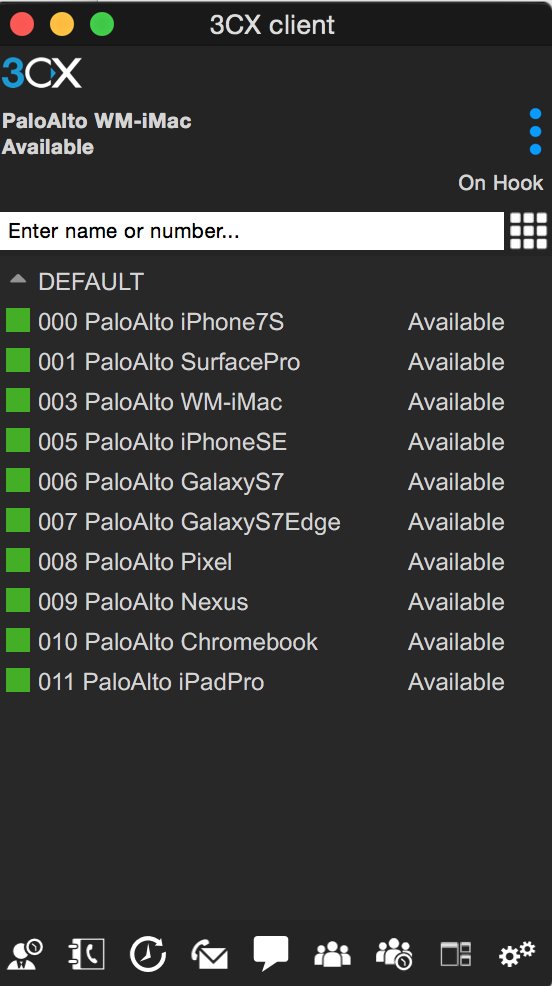
Published: Monday, October 16, 2017

Need help with Asterisk? Visit the PBX in a Flash Forum.
Special Thanks to Our Generous Sponsors
FULL DISCLOSURE: ClearlyIP, Skyetel, Vitelity, DigitalOcean, Vultr, VoIP.ms, 3CX, Sangoma, TelecomsXchange and VitalPBX have provided financial support to Nerd Vittles and our open source projects through advertising, referral revenue, and/or merchandise. As an Amazon Associate and Best Buy Affiliate, we also earn from qualifying purchases. We’ve chosen these providers not the other way around. Our decisions are based upon their corporate reputation and the quality of their offerings and pricing. Our recommendations regarding technology are reached without regard to financial compensation except in situations in which comparable products at comparable pricing are available from multiple sources. In this limited case, we support our sponsors because our sponsors support us.
 BOGO Bonaza: Enjoy state-of-the-art VoIP service with a $10 credit and half-price SIP service on up to $500 of Skyetel trunking with free number porting when you fund your Skyetel account. No limits on number of simultaneous calls. Quadruple data center redundancy. $25 monthly minimum spend required. Tutorial and sign up details are here.
BOGO Bonaza: Enjoy state-of-the-art VoIP service with a $10 credit and half-price SIP service on up to $500 of Skyetel trunking with free number porting when you fund your Skyetel account. No limits on number of simultaneous calls. Quadruple data center redundancy. $25 monthly minimum spend required. Tutorial and sign up details are here.
 The lynchpin of Incredible PBX 2020 and beyond is ClearlyIP components which bring management of FreePBX modules and SIP phone integration to a level never before available with any other Asterisk distribution. And now you can configure and reconfigure your new Incredible PBX phones from the convenience of the Incredible PBX GUI.
The lynchpin of Incredible PBX 2020 and beyond is ClearlyIP components which bring management of FreePBX modules and SIP phone integration to a level never before available with any other Asterisk distribution. And now you can configure and reconfigure your new Incredible PBX phones from the convenience of the Incredible PBX GUI.
 VitalPBX is perhaps the fastest-growing PBX offering based upon Asterisk with an installed presence in more than 100 countries worldwide. VitalPBX has generously provided a customized White Label version of Incredible PBX tailored for use with all Incredible PBX and VitalPBX custom applications. Follow this link for a free test drive!
VitalPBX is perhaps the fastest-growing PBX offering based upon Asterisk with an installed presence in more than 100 countries worldwide. VitalPBX has generously provided a customized White Label version of Incredible PBX tailored for use with all Incredible PBX and VitalPBX custom applications. Follow this link for a free test drive!
 Special Thanks to Vitelity. Vitelity is now Voyant Communications and has halted new registrations for the time being. Our special thanks to Vitelity for their unwavering financial support over many years and to the many Nerd Vittles readers who continue to enjoy the benefits of their service offerings. We will keep everyone posted on further developments.
Special Thanks to Vitelity. Vitelity is now Voyant Communications and has halted new registrations for the time being. Our special thanks to Vitelity for their unwavering financial support over many years and to the many Nerd Vittles readers who continue to enjoy the benefits of their service offerings. We will keep everyone posted on further developments.
Some Recent Nerd Vittles Articles of Interest…
The Ultimate Voice Dialer for Asterisk and Incredible PBX

Let’s face it. Voice recognition with Google has been hit and miss, and that’s on a good day. So we’re delighted to shift gears and introduce a new platform powered by IBM Watson’s Speech-to-Text (STT) engine. While it’s not free, that’s really theoretical for most of our readers. Your first month on the platform is entirely free. And, after that, you get 1,000 minutes a month of free voice recognition services. If you still want more, it’s 2¢ a minute.
We first introduced IBM’s STT platform back in March when we documented how to use the service to transcribe voicemails and deliver them via email. Today, we’re introducing the Incredible Voice Dialer for Asterisk. It runs on all of the major Incredible PBX platforms: CentOS, Wazo, and Issabel. It’s married to our AsteriDex phonebook application that is deployed with Incredible PBX using MySQL, MariaDB, or SQLite3 depending upon platform.
The way it works is a user picks up an extension on your PBX and dials 411. The caller will be prompted for the name of the person or company to call. Once the caller says the name, the Incredible Voice Dialer will send the recording to IBM’s Watson STT engine for transcription. The result is then passed to AsteriDex where the text will be matched against the phone number saved for that person or company. The number is then passed to your default outbound trunk to place the call. All of the magic happens in less than two seconds, and the call begins ringing at your destination. You can try it out for yourself on our demo server this week. Just dial:  , choose option 1 when the IVR answers, and then say "Delta Airlines" or "American Airlines" when prompted for a name. The queries support wildcard matching. If you say "Delta", you’ll still be connected to Delta Airlines.
, choose option 1 when the IVR answers, and then say "Delta Airlines" or "American Airlines" when prompted for a name. The queries support wildcard matching. If you say "Delta", you’ll still be connected to Delta Airlines.
What About the Quality? Here’s the bottom line. Speech recognition isn’t all that useful if it fails miserably in recognizing everyday speech. The good news is that IBM Watson’s speech recognition engine is now the best in the business. If you want more details, read the article below which will walk you through IBM’s latest speech recognition breakthrough:
Why IBM's speech recognition breakthrough matters for AI and IoT. Via @techrepublic https://t.co/AJi8MA3E20
— IBM Developer (@IBMDeveloper) March 15, 2017
Creating an IBM Bluemix Speech to Text Account
NOV. 1 UPDATE: IBM has moved the goal posts effective December 1, 2018:

1. Create Bluemix account here.
2. Confirm your registration by replying to email from IBM.
3. Login to Bluemix using your new credentials.
4. Agree to terms and conditions, name your organization, and name your space (STT).
5. Choose Watson Speech to Text service and click Create.
6. When Speech to Text-kb opens, click Service Credentials tab (on the left).
7. In Actions column, click View Credentials. Write down your username and password.
8. Logout by clicking on image icon in upper right corner of dialog window.
Install Voice Dialer with Incredible PBX for Wazo
1. Login to your server as root using SSH/Putty and issue the following commands:
cd / wget http://incrediblepbx.com/ibmstt-411-wazo.tar.gz tar zxvf ibmstt-411-wazo.tar.gz rm -f ibmstt-411-wazo.tar.gz sed -i '\\:// BEGIN Call by Name:,\\:// END Call by Name:d' /etc/asterisk/extensions_extra.d/xivo-extrafeatures.conf sed -i '/\\[xivo-extrafeatures\\]/r /tmp/411.txt' /etc/asterisk/extensions_extra.d/xivo-extrafeatures.conf asterisk -rx "dialplan reload"
2. Edit /var/lib/asterisk/agi-bin/getnumber.sh and insert your IBM credentials from step #7 above into these variables:
API_USERNAME="XXXXXXXX-XXXX-XXXX-XXXX-XXXXXXXXXXXX" API_PASSWORD="XXXXXXXXXXXX"
3. Save the file.
Install Voice Dialer on Other Incredible PBX Platforms
1. Login to your server as root using SSH/Putty and issue the following commands:
cd / wget http://incrediblepbx.com/ibmstt-411.tar.gz tar zxvf ibmstt-411.tar.gz rm -f ibmstt-411.tar.gz sed -i '\\:// BEGIN Call by Name:,\\:// END Call by Name:d' /etc/asterisk/extensions_custom.conf sed -i '/\\[from-internal-custom\\]/r /tmp/411.txt' /etc/asterisk/extensions_custom.conf asterisk -rx "dialplan reload"
2. Edit /var/lib/asterisk/agi-bin/getnumber.sh and insert your IBM credentials from step #7 above into these variables:
API_USERNAME="XXXXXXXX-XXXX-XXXX-XXXX-XXXXXXXXXXXX" API_PASSWORD="XXXXXXXXXXXX"
3. Save the file.
Take Incredible Voice Dialer for a Test Drive
1. From an extension connected to your PBX, dial 411. When prompted for the name to call, say "Delta Airlines" or "American Airlines."
2. Quicker than you could actually dial the number, you’ll be connected.
Building Voice-Enabled Applications with Asterisk
All of our code is open source, GPL2 code so you’re more than welcome to use it, learn from it, and then build your own voice-enabled applications. Just abide by the terms of the license and share. When you review /var/lib/asterisk/agi-bin/getnumber.sh, you’ll see that it’s incredibly easy to change the backend database. Here’s the Wazo flavor of the script:
API_USERNAME="XXXXXXXX-XXXX-XXXX-XXXX-XXXXXXXXXXXX" API_PASSWORD="XXXXXXXXXXXX" thisfile="$1" # sending the recording to IBM Watson for transcription curl -k -u $API_USERNAME:$API_PASSWORD -X POST --limit-rate 40000 --header "Content-Type: audio/wav" --data-binary @/tmp/$thisfile.wav "https://stream.watsonplatform.net/speech-to-text/api/v1/recognize?continuous=true&model=en-US_NarrowbandModel" 1>/tmp/$thisfile.txt # grabbing the text out of the IBM Watson response msg=`cat /tmp/$thisfile.txt | grep transcript | cut -f 2 -d ":" | cut -f 2 -d '"' | sed 's| *$||' | sed -e "s/\b\(.\)/\u\1/g"`% # passing text to MySQL (1st line) or SQLite3 (2nd line) for name lookup. answer is num2call. #num2call=$(mysql -uroot -ppassw0rd asteridex -ss -N -e "SELECT user1.out FROM user1 where name LIKE '$msg'"); num2call=`/usr/bin/sqlite3 /var/lib/asterisk/agi-bin/asteridex.sqlite "select out from user1 where name LIKE '$msg'"` # clearing out our temporary files rm -f /tmp/$thisfile.* # passing the results to the Asterisk dialplan echo "SET VARIABLE PTY2CALL "\""$msg"\""" echo "SET VARIABLE NUM2CALL "\""$num2call"\""" # we're done with the AGI bash script so let's exit gracefully exit 0
The Asterisk dialplan code could be modified for any number of applications. Here’s what it looks like on the Incredible PBX 13 platform. It’s slightly different with Wazo to accomodate their dialplan syntax.
;# // BEGIN Call by Name
exten => 411,1,Answer
exten => 411,n,Playback(custom/411)
exten => 411,n,Set(RANDFILE=${RAND(8000,8599)})
exten => 411,n,Record(/tmp/${RANDFILE}.wav,3,10)
exten => 411,n,Playback(/tmp/${RANDFILE})
exten => 411,n,AGI(getnumber.sh,${RANDFILE})
exten => 411,n,NoOp(Party to call : ${PTY2CALL})
exten => 411,n,NoOp(Number to call: ${NUM2CALL})
exten => 411,n,Goto(outbound-allroutes,${NUM2CALL},1)
exten => 411,n,Hangup()
;# // END Call by Name
There’s nothing magical about it. (1) It answers the call to 411. (2) It plays back a recording that prompts the user to say the name of the person or company to call. (3) It generates a random number to use for the filenames associated with the STT process. (4) It records the caller’s speech and saves it to the random filename as a .wav file which IBM STT can understand. (5) It passes the call to the AGI bash script to send the recording to IBM Watson and obtain the transcription and to pass the text to MySQL or SQLite3 to lookup the text in the AsteriDex database. (6) We display the called party’s name on the Asterisk CLI. (7) We display the called party’s phone number on the Asterisk CLI. (8) We place the call using the PBX’s default outbound route. (9) We hangup the call when it’s completed.
Published: Monday, October 9, 2017

Need help with Asterisk? Visit the PBX in a Flash Forum.
Special Thanks to Our Generous Sponsors
FULL DISCLOSURE: ClearlyIP, Skyetel, Vitelity, DigitalOcean, Vultr, VoIP.ms, 3CX, Sangoma, TelecomsXchange and VitalPBX have provided financial support to Nerd Vittles and our open source projects through advertising, referral revenue, and/or merchandise. As an Amazon Associate and Best Buy Affiliate, we also earn from qualifying purchases. We’ve chosen these providers not the other way around. Our decisions are based upon their corporate reputation and the quality of their offerings and pricing. Our recommendations regarding technology are reached without regard to financial compensation except in situations in which comparable products at comparable pricing are available from multiple sources. In this limited case, we support our sponsors because our sponsors support us.
 BOGO Bonaza: Enjoy state-of-the-art VoIP service with a $10 credit and half-price SIP service on up to $500 of Skyetel trunking with free number porting when you fund your Skyetel account. No limits on number of simultaneous calls. Quadruple data center redundancy. $25 monthly minimum spend required. Tutorial and sign up details are here.
BOGO Bonaza: Enjoy state-of-the-art VoIP service with a $10 credit and half-price SIP service on up to $500 of Skyetel trunking with free number porting when you fund your Skyetel account. No limits on number of simultaneous calls. Quadruple data center redundancy. $25 monthly minimum spend required. Tutorial and sign up details are here.
 The lynchpin of Incredible PBX 2020 and beyond is ClearlyIP components which bring management of FreePBX modules and SIP phone integration to a level never before available with any other Asterisk distribution. And now you can configure and reconfigure your new Incredible PBX phones from the convenience of the Incredible PBX GUI.
The lynchpin of Incredible PBX 2020 and beyond is ClearlyIP components which bring management of FreePBX modules and SIP phone integration to a level never before available with any other Asterisk distribution. And now you can configure and reconfigure your new Incredible PBX phones from the convenience of the Incredible PBX GUI.
 VitalPBX is perhaps the fastest-growing PBX offering based upon Asterisk with an installed presence in more than 100 countries worldwide. VitalPBX has generously provided a customized White Label version of Incredible PBX tailored for use with all Incredible PBX and VitalPBX custom applications. Follow this link for a free test drive!
VitalPBX is perhaps the fastest-growing PBX offering based upon Asterisk with an installed presence in more than 100 countries worldwide. VitalPBX has generously provided a customized White Label version of Incredible PBX tailored for use with all Incredible PBX and VitalPBX custom applications. Follow this link for a free test drive!
 Special Thanks to Vitelity. Vitelity is now Voyant Communications and has halted new registrations for the time being. Our special thanks to Vitelity for their unwavering financial support over many years and to the many Nerd Vittles readers who continue to enjoy the benefits of their service offerings. We will keep everyone posted on further developments.
Special Thanks to Vitelity. Vitelity is now Voyant Communications and has halted new registrations for the time being. Our special thanks to Vitelity for their unwavering financial support over many years and to the many Nerd Vittles readers who continue to enjoy the benefits of their service offerings. We will keep everyone posted on further developments.
Some Recent Nerd Vittles Articles of Interest…
Game Changer: Hooking Up Facebook with Incredible PBX

There aren’t many VoIP discoveries that get us this excited about the future of telecom. But merging with 1.5 billion users plus Facebook’s enormous talent pool and technology resources is definitely something worthy of your attention. What a Facebook marriage with the VoIP platform could mean for the future of telecommunications is nothing short of earth-shattering. Few people still have home phones. Almost everyone has a Facebook account and a cellphone. If VoIP solutions for businesses fail to take those last two sentences into account, commercial PBX’s days are numbered… and it’s not a big number.
So why integrate Facebook Messenger into your PBX? The screenshot above says it all.
Think of the possibilities. Using Facebook Messenger on your smartphone or desktop PC, you could query a CRM database running on your VoIP server and instantly connect to anyone in the world by making a free call or sending a free text message. Using Facebook Messenger, you or any designated employee could receive instant alerts when a new voicemail or fax arrived on your PBX. Using Facebook Messenger, the Call Center possibilities are virtually endless as documented here. Using Facebook Messenger, you as an administrator could literally manage your entire fleet of PBXs from the convenience of your smartphone… anywhere in the world. While the Facebook Messenger platform does not independently support phone calls between its users today, it’s just a matter of time. Look at the name of the product. Is there any doubt where this project is headed given the fact that Apple already supports free calling with Facetime, Microsoft supports free calling with Skype, Google supports free calling with Google Voice, and Amazon supports free calling with its Echo platform?
Facebook integration is revolutionary in another way as well. It heralds the arrival of chatbots to do the heavy lifting for telecom businesses as well as system administrators. Just as ATMs revolutionized banking, chatbots are poised to do much the same thing for communications and Internet support. Down the road, we’ll document how to take advantage of this chatbot technology using Facebook Messenger.
We need to learn to walk before we can run. So today we’ve developed a Facebook webhooks integration project for Incredible PBX® that is perfect for administrators, whether you manage a home PBX or a dozen PBXs for an organization. We’ll get to some of the other possibilities in future articles. Setting this up is the best way we can think of to get your creative juices flowing to consider what’s possible and to identify where to go next. When we’re finished, you’ll have a Facebook Messenger platform from which you can issue any Linux® or Asterisk® command to your server. And, you’ll be able to send messages from your PBX to Facebook Messenger to identify any events you wish to monitor, whether it’s phone calls, or voicemails, or receipt of faxes, or even VoIP provider outages. In addition, you can even reroute calls by entering simple call forwarding commands in Messenger.
Before we get started, let’s get all of the legal stuff out of the way up front. WE PROVIDE OPEN SOURCE, GPL CODE TO OUR READERS AT NO COST. ALWAYS HAVE. ALWAYS WILL. THE TRADEOFF IS YOU MUST AGREE TO ACCEPT ALL RISKS INHERENT IN USING THE SOFTWARE, WHETHER THOSE RISKS ARE KNOWN OR UNKNOWN TO YOU OR TO US. THE SOFTWARE IS PROVIDED "AS IS" AND MAY BE USED AS DELIVERED, OR YOU MAY MODIFY IT TO MEET YOUR OWN NEEDS SUBJECT TO THE TERMS OF THE GPL 2 LICENSE AVAILABLE HERE. IF YOU ARE UNWILLING TO AGREE TO THESE TERMS AND CONDITIONS, STOP READING HERE AND MOVE ON TO SOME OTHER WEB SITE. OTHERWISE, LET’S BEGIN WHAT WE PROMISE WILL BE A TERRIFIC ADVENTURE.
Overview of Facebook Messenger Webhooks Project
Here is a thumbnail sketch of what we’ll be covering today. Once you get an SSL certificate installed for your server, the remaining steps are a walk in the park. When we’re finished, you’ll have a Facebook Messenger platform that is seamlessly integrated with your PBX. The current software release supports Incredible PBX 13 with CentOS 6, Incredible PBX for Issabel, and Incredible PBX for Wazo. Minor tweaking required for other Asterisk platforms.
- SSL Certificate – Obtaining and installing an SSL certificate for your web server
- Security – Locking down your server for safe, secure Facebook Messenger access
- Incredible PBX Webhooks App – Installing the server-side webhooks software
- Facebook Integration – Interconnecting Facebook Messenger and Incredible PBX
- Outbound Call Setup – Configuring Incredible PBX to make outbound calls from FB
- Incoming Call Alerts – Configuring Incredible PBX for FB Messenger call alerts
- Webhooks Feature Set – Our tutorial covering all supported webhook commands
- SMS Messaging – Configuring Incredible PBX for SMS Messaging support with FB
- Webhooks Tips & Tricks – Adjusting our code to meet your own requirements
Obtaining and Installing an SSL Certificate
Believe it or not, the hardest part of today’s project was covered in last week’s Nerd Vittles tutorial. It walked you through obtaining and installing an SSL Certificate on any of the major Incredible PBX platforms. This gets your server configured to use secure and encrypted web communications via HTTPS which is both a Facebook requirement and a smart idea. There’s no need to read further until you get your server working properly with an SSL certificate because the Facebook integration component will fail until you get HTTPS access squared away. So start there and return here when you’re finished.
The Most Important Piece of the Puzzle: SECURITY
If you’ve been following Nerd Vittles over the years, you already know that our most important consideration with any PBX deployment is security. A PBX without a secure firewall is an invitation for an astronomical phone bill. Today’s setup assumes you already have deployed Incredible PBX with its Travelin’ Man 3 firewall that provides a whitelist of IP addresses that may access (or even see) your server. By definition, Facebook Messenger is a public platform available to everyone in the world. So how do we safely integrate it into your PBX while preserving the security of your server and its telecom resources? We do it in several ways. First, Facebook Messenger Webhooks are tied to a commercial Facebook page even though you don’t need a business in order to create the page. As the owner of that Facebook Page, you have to authorize users to access the page. DON’T! Make this a page that is solely dedicated to managing your PBX through Messenger. DO NOT USE THIS FACEBOOK PAGE AS THE PUBLIC FACE FOR YOUR BUSINESS! Also make certain that your Facebook credentials include a very secure password… as if the integrity of your PBX depended upon it. IT DOES! So long as you follow these guidelines, Facebook’s own security mechanisms will protect your PBX from intrusion. If this discussion makes you nervous, our last topic today will show you how to remove components from the code to eliminate any functionality you wish to turn off.
As configured, Facebook Messenger Webhooks won’t work at all with Incredible PBX because the firewall should block all web access to your server. This requires a change on the Incredible PBX for Wazo platform which we will cover momentarily. The way we will provide Facebook access is by adding the Facebook server IP addresses to the existing whitelist, and then we’ll run a bash script every night to keep the Facebook IP addresses current.
In the past, we opened TCP port 443 (HTTPS) to public access on the firewall with Incredible PBX for Wazo. Instead, we relied upon web server authentication for access to the Wazo, Telephone Reminders, and AsteriDex services. That needs to be changed before you interconnect with Facebook Messenger, and we’ll include that in the commands to whitelist the Facebook servers below.
1. To secure port 443 in your firewall, be sure that the port is not exposed in /etc/sysconfig/iptables (CentOS) or /etc/iptables/rules.v4 (Debian/Ubuntu/Raspbian). And then restart the Incredible PBX firewall.
sed -i 's|443|450|' /etc/sysconfig/iptables sed -i 's|443|450|' /etc/iptables/rules.v4 iptables-restart
2. Verify your new configuration: iptables -nL. Search for 443 and make certain it is NOT in the whitelist.
3. Verify that the whois package is installed on your server by issuing the command: whois. If you get a file not found error, install the package using the top line for CentOS and the bottom line for Debian/Ubuntu/Raspbian:
yum install whois apt-get install whois
4a. For Issabel and Incredible PBX 13, add to the end of /usr/local/sbin/iptables-restart these lines to whitelist the FB servers. Then restart the firewall: iptables-restart
whois -h whois.radb.net -- '-i origin AS32934' | grep ^route: | sed "s|route: |/usr/sbin/iptables -A INPUT -s |" | sed "s|$| -p tcp -m tcp --dport 443 -j ACCEPT|" > /usr/local/sbin/iptables-facebook chmod +x /usr/local/sbin/iptables-facebook /usr/local/sbin/iptables-facebook
4b. For Incredible PBX for Wazo, add to end of /usr/local/sbin/iptables-restart these lines to whitelist the FB servers. Then restart the firewall: iptables-restart
whois -h whois.radb.net -- '-i origin AS32934' | grep ^route: | sed "s|route: |/sbin/iptables -A INPUT -s |" | sed "s|$| -p tcp -m tcp --dport 443 -j ACCEPT|" > /usr/local/sbin/iptables-facebook chmod +x /usr/local/sbin/iptables-facebook /usr/local/sbin/iptables-facebook
5. Verify your new configuration: iptables -nL. You should see numerous whitelist entries for port 443 at the end of the listing.
6. Add the following command at the bottom of /etc/crontab to assure that the Facebook server IP addresses are kept current:
20 0 * * * root /usr/local/sbin/iptables-restart >/dev/null 2>&1
7a. For Issabel and Incredible PBX 13, create new web directory, set ownership/permissions to house the Facebook Messenger webhooks, and add a sample web page:
mkdir /var/www/html/fb echo "Hello World" > /var/www/html/fb/index2.php chown -R asterisk:asterisk /var/www/html/fb
7b. For Incredible PBX for Wazo, create web directory, set ownership/permissions to house the Facebook Messenger webhooks, and add a sample web page:
mkdir /var/www/html/fb echo "Hello World" > /var/www/html/fb/index2.php chown -R asterisk:www-data /var/www/html/fb chmod -R 775 /var/www/html/fb
8a. For Issabel and Incredible PBX 13, no further configuration is required.
8b. For Incredible PBX for Wazo, we need to enable access to the fb web directory. Edit /etc/nginx/locations/https-available/01_incrediblepbx:
At the top of the file, add the following:
location ~* ^/fb/. *\(?:ico|css|js|gif|jpe?g|png)${
root /var/www/html;
}
At the bottom of the file, add the following:
location ~ /fb/ {
root /var/www/html;
index index.php;
try_files $uri $uri/ =404;
fastcgi_param SCRIPT_FILENAME $document_root$fastcgi_script_name;
fasstcgi_index index.php;
include fastcgi_params;
fastcgi_pass unix:/var/run/php5-fpm.sock;
}
Finally, restart the NGINX web server: service nginx restart
9. Using a browser, verify access to sample page: https://SERVER-FQDN/fb/index2.php
Installing Incredible PBX Webhooks Application
Now it’s time to install the Incredible PBX webhooks application on your PBX:
cd /var/www/html/fb wget http://incrediblepbx.com/incrediblewebhooks.tar.gz tar zxvf incrediblewebhooks.tar.gz rm incrediblewebhooks.tar.gz
For Issabel and Incredible PBX 13, adjust the file ownership and permissions like this:
chown -R asterisk:asterisk /var/www/html/fb chmod -R 775 /var/www/html/fb
For Incredible PBX for Wazo, adjust the file ownership and permissions like this:
chown -R asterisk:www-data /var/www/html/fb chmod -R 775 /var/www/html/fb
Hooking Up with Facebook
1. Visit the Facebook Developer’s Page and click Add a New App. Give your app a Display Name and provide your Contact Email. Match the letters in the box to get past the Security Check to display the Facebook Product List.
2. When the Facebook Product List appears, click Messenger and choose Setup.
3. In the Token Generation section, click Create a new Facebook Business Page to open a separate browser tab. Do NOT use a page that you use for other purposes! Company, Organization, or Institution is a good choice because there’s a Telecom Company category. Give your new page a Descriptive Name: incrediblepbx-podunk.
4. Return to your Token Generation browser tab and Select the Page you just created from the pull-down list (see Token Generation section of image below). Click Continue and OK to accept the default settings. Facebook then will generate a Page Access Token.
5. Copy the Page Access Token to your clipboard and paste it into the $access_token variable in the config.inc.php template in /var/www/html/fb. Write it down and keep it in a safe place. You’ll always need it to create new webhooks applications. This is the important link to talk to your Facebook Webhooks.
6. In the Webhooks section, click Setup Webhooks. In the Page Subscription form, enter the callback URL for your page. This is the https address to access your Facebook directory with a browser, e.g. https://YOUR-FQDN/fb. Make up a very secure Verify Token and enter it on the form and in the $verify_token variable in the config.inc.php template. This is the code Facebook will send to initially shake hands with your web page. The two entries must match to successfully set up your webhooks linkage. For Subscription Fields, check the Messages box. Then click Verify and Save. If it worked, you’ll get a Complete checkmark in the Webhooks section (see below). The last step is to again Select your Page in the Webhooks section to interconnect Facebook with your PBX. After choosing your page, be sure to click Subscribe or nothing will work. Here’s what a successful setup looks like:
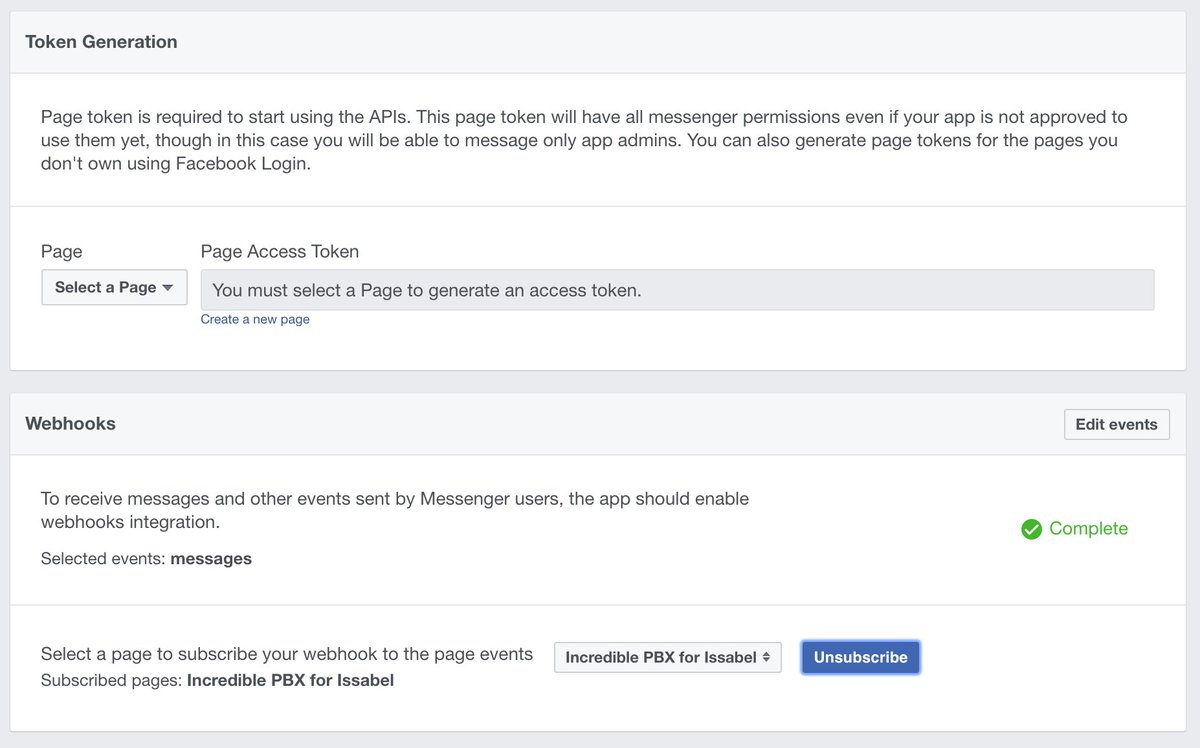
7. To test things out, open Facebook Messenger on a desktop PC, Mac, or smartphone. Search Messenger for the Facebook page you linked to in the previous step. Then click on it to open it. Type howdy in the Message Box at the bottom of the dialog and click Send.
8. You should get an automated response that looks like this:
Hi there and welcome to BotWorld. SenderID: 13824822489535983
9. Copy the SenderID and paste it into cli-message.php together with Page Access Token from step #5, above.
Outbound Call Setup for Facebook Messenger
Outbound calling with Facebook Messenger works like this. You can connect to a specific number using the dial command. Or you can use the call command to look up an entry in your AsteriDex database. Messenger then will display the matching phone number and give you the option of placing the call. When the call is initiated, Incredible PBX will first call your designated CALL-PICKUP-NUMBER. It could be an extension or ring group of your choice. You could even specify a mobile phone number as the pickup destination provided your PBX supports at least two simultaneous outbound calls. Google Voice and many SIP providers can handle this with a single DID. Our personal preference is to route the pickup call to a trunk on a 3CX server which then sends the call to every 3CX client registered with the 3CX server. No NAT issues ever! Once you pick up the call on your designated phone, Incredible PBX will place the second call to the number you requested in Facebook Messenger. The two calls then are connected as if you had placed the call directly. The brief video below demonstrates how this works and the flexibility of using Acer’s $250 Chromebook Flip with Messenger and a 3CX client as a (free) WiFi-based web communications platform with Google Voice. It lets you place and take calls from anywhere in the world so long as you have Wi-Fi access. It’s a dirt cheap travel companion.
To make all of this work, you need to designate a phone in /var/www/html/fb/.cli-call to take outbound calls initiated from Facebook Messenger. This is either an extension number or a 10-digit CALL-PICKUP-NUMBER in the examples below. To set this up, edit .cli-call and choose one of the following examples. Comment out the other Channel options.
For Issabel and Incredible PBX 13, choose from the following:
#echo "Channel: SIP/701" > /tmp/cli.call #echo "Channel: SIP/vitel-outbound/1CALL-PICKUP-NUMBER" > /tmp/cli-call echo "Channel: Motif/gSOME-GV-NAMEgmailcom/1CALL-PICKUP-NUMBER@voice.google.com" > /tmp/cli.call
For Incredible PBX for Wazo, choose from the following:
echo "Channel: Local/701@default" > /tmp/cli.call #echo "Channel: Local/CALL-PICKUP-NUMBER@default" > /tmp/cli.call
Incoming Call Alerts with Facebook Messenger
If you’ve always wished for screenpops to announce your incoming calls, you’re going to drool at the FB Messenger Webhooks implementation with Incredible PBX. It works (simultaneously) on desktop PCs, Macs, iPhones/iPads, Android devices, and Apple Watch:
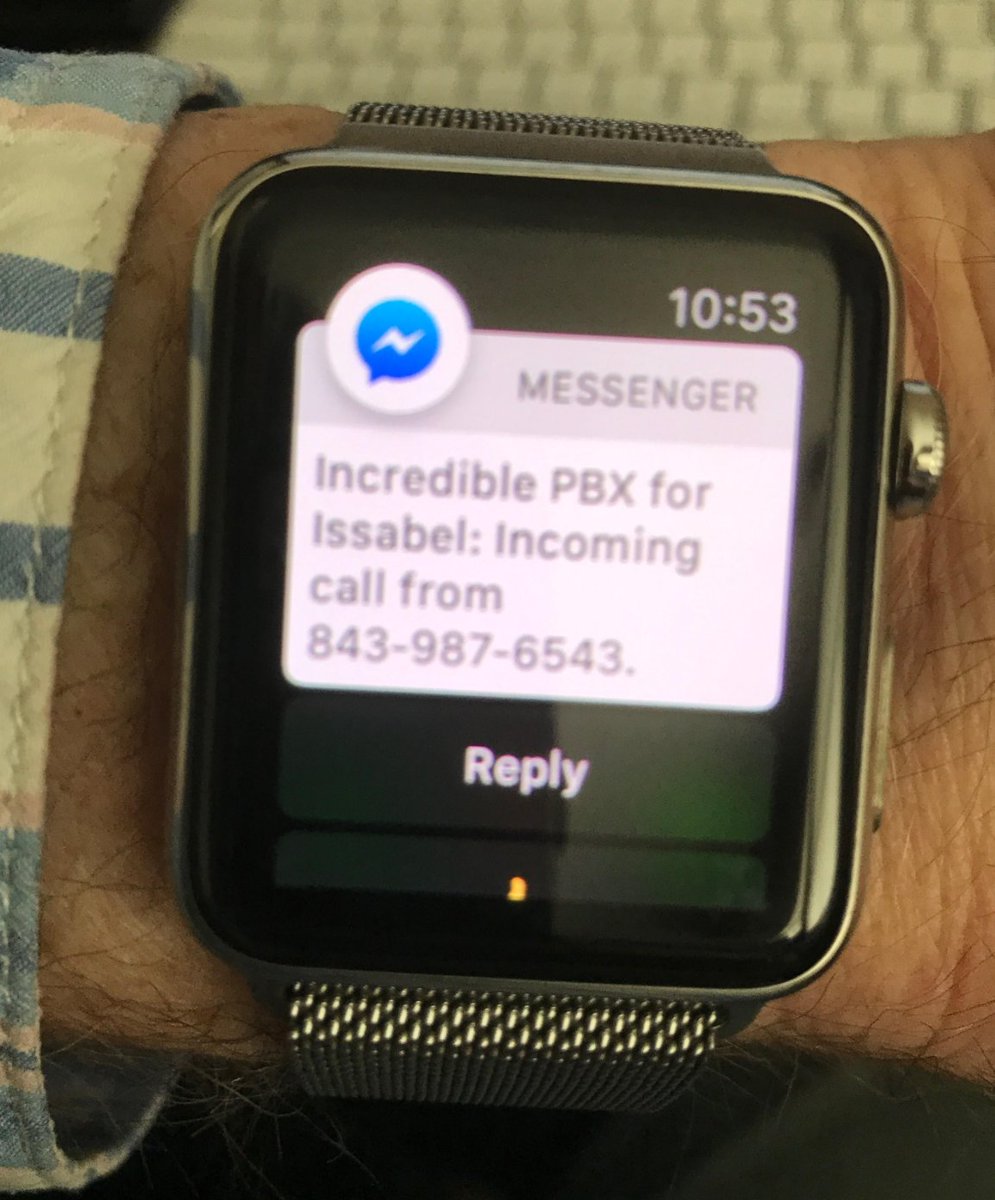
To set up incoming call alerts with Facebook Messenger, just issue the commands for your platform as outlined below.
For Incredible PBX 13, add the following to the end of extensions_override_freepbx.conf in /etc/asterisk directory. Then reload Asterisk dialplan: asterisk -rx "dialplan reload"
[cidlookup]
include => cidlookup-custom
exten => cidlookup_1,1,Set(CURLOPT(httptimeout)=7)
exten => cidlookup_1,n,Set(CALLERID(name)=${CURL(https://api.opencnam.com/v2/phone/${CALLERID(num)}?format=pbx&ref=freepbx)})
exten => cidlookup_1,n,Set(current_hour=${STRFTIME(,,%Y-%m-%d %H)})
exten => cidlookup_1,n,Set(last_query_hour=${DB(cidlookup/opencnam_last_query_hour)})
exten => cidlookup_1,n,Set(total_hourly_queries=${DB(cidlookup/opencnam_total_hourly_queries)})
exten => cidlookup_1,n,ExecIf($["${last_query_hour}" != "${current_hour}"]?Set(DB(cidlookup/opencnam_total_hourly_queries)=0))
exten => cidlookup_1,n,ExecIf($["${total_hourly_queries}" = ""]?Set(DB(cidlookup/opencnam_total_hourly_queries)=0))
exten => cidlookup_1,n,Set(DB(cidlookup/opencnam_total_hourly_queries)=${MATH(${DB(cidlookup/opencnam_total_hourly_queries)}+1,i)})
exten => cidlookup_1,n,ExecIf($[${DB(cidlookup/opencnam_total_hourly_queries)} >= 60]?System(${ASTVARLIBDIR}/bin/opencnam-alert.php))
exten => cidlookup_1,n,Set(DB(cidlookup/opencnam_last_query_hour)=${current_hour})
exten => cidlookup_1,n,System(/usr/bin/php /var/www/html/fb/cli-message.php "Incoming call: ${CALLERID(number)} - ${CALLERID(name)}.")
exten => cidlookup_1,n,Return()
exten => cidlookup_return,1,ExecIf($["${DB(cidname/${CALLERID(num)})}" != ""]?Set(CALLERID(name)=${DB(cidname/${CALLERID(num)})}))
exten => cidlookup_return,n,Return()
;--== end of [cidlookup] ==--;
For Incredible PBX for Issabel, add this to the end of extensions_override_issabel.conf in /etc/asterisk directory. Then reload Asterisk dialplan: asterisk -rx "dialplan reload"
[cidlookup]
include => cidlookup-custom
exten => cidlookup_5,1,Set(CURLOPT(httptimeout)=7)
exten => cidlookup_5,n,Set(CALLERID(name)=${CURL(https://api.opencnam.com/v2/phone/${CALLERID(num)}?format=pbx&ref=issabelpbx)})
exten => cidlookup_5,n,Set(current_hour=${STRFTIME(,,%Y-%m-%d %H)})
exten => cidlookup_5,n,Set(last_query_hour=${DB(cidlookup/opencnam_last_query_hour)})
exten => cidlookup_5,n,Set(total_hourly_queries=${DB(cidlookup/opencnam_total_hourly_queries)})
exten => cidlookup_5,n,ExecIf($["${last_query_hour}" != "${current_hour}"]?Set(DB(cidlookup/opencnam_total_hourly_queries)=0))
exten => cidlookup_5,n,ExecIf($["${total_hourly_queries}" = ""]?Set(DB(cidlookup/opencnam_total_hourly_queries)=0))
exten => cidlookup_5,n,Set(DB(cidlookup/opencnam_total_hourly_queries)=${MATH(${DB(cidlookup/opencnam_total_hourly_queries)}+1,i)})
exten => cidlookup_5,n,ExecIf($[${DB(cidlookup/opencnam_total_hourly_queries)} >= 60]?System(${ASTVARLIBDIR}/bin/opencnam-alert.php))
exten => cidlookup_5,n,Set(DB(cidlookup/opencnam_last_query_hour)=${current_hour})
exten => cidlookup_5,n,System(/usr/bin/php /var/www/html/fb/cli-message.php "Incoming call: ${CALLERID(number)} - ${CALLERID(name)}.")
exten => cidlookup_5,n,Return()
exten => cidlookup_return,1,ExecIf($["${DB(cidname/${CALLERID(num)})}" != ""]?Set(CALLERID(name)=${DB(cidname/${CALLERID(num)})}))
exten => cidlookup_return,n,Return()
;--== end of [cidlookup] ==--;
For Incredible PBX for Wazo, edit /etc/asterisk/extensions_extra.d/cid-superfecta.conf. In the [xivo-subrgbl-did] context just below the n(keepon),Gosub(cid-superfecta,s,1) line, insert the following. Then reload the Asterisk dialplan: asterisk -rx "dialplan reload"
same = n,System(/usr/bin/php /var/www/html/fb/cli-message.php "Incoming call: ${XIVO_SRCNUM} - ${CALLERID(name)}.")
Incredible PBX Webhooks Feature Set
Now that we’ve got all the pieces in place and properly configured, let’s briefly walk through the various options that are available. With all commands, you use Facebook Messenger with your designated web page on any platform supported by Messenger.
dial 8005551212 – connects to designated extension and then calls 8005551212
call Delta – looks up Delta in AsteriDex and provides button to place the call
lookup Delta – looks up Delta in AsteriDex and provides button to place the call
!command – executes a Linux command, e.g. !asterisk -rx "sip show registry"
howdy – returns greeting and SENDER ID of your FB page (Hookup, item #9)
help – provides links to phone help as well as PIAF and Asterisk forums
sms 10-digit-SMS-number "Some message" – sends SMS message through GV
update – updates Messenger platform for Incredible PBX to the latest & greatest
anything else – returns whatever you typed as a response (for now)
Configuring Incredible PBX for SMS Messaging
We’ve implemented a traditional SMS messaging function in this build that let’s you send an SMS message to any phone if you have a Google Voice account and assuming you have pygooglevoice functioning properly on your PBX. The Google Voice account need not be registered as a trunk on the PBX. To use the feature, insert your Google Voice credentials including your plain-text password for a working Google Voice account in /var/www/html/fb/.smssend. Then test the SMS functionality by issuing the following command from the Linux CLI:
/var/www/html/fb/.smssend 10-DIGIT-SMS-NUMBER "Hello SMS World"

If an error occurs, the script will tell you what to try to fix it. Begin by Enabling Less Secure Apps. Then follow this link to relax Google Voice security on your account. If it still fails after trying both of these methods, you may have an old build of pygooglevoice. Here are the commands to bring your system up to current specs. Then try again.
cd /root rm -r pygooglevoice git clone https://github.com/wardmundy/pygooglevoice.git cd pygooglevoice python setup.py install cp -p bin/gvoice /usr/bin/.
Once you’ve sent an SMS message successfully using .smssend, you can start sending SMS messages from within Messenger. Syntax: sms 10-digit-SMS-number "Some message"
Incredible PBX Webhooks Tips & Tricks
There’s lots to learn with Facebook Messenger Webhooks. When we started two weeks ago, there were no PHP resources on the web that offered much help. Lucky for you, our pain is your gain. The meat of the coconut is primarily stored in the index.php in your fb directory. Print it out and it will tell you everything you ever wanted to know about coding webhooks with PHP.
Disabling Shell Access. While shell access only provides asterisk or www-data permissions depending upon your platform, we’ve nevertheless heard from more than one source exclaiming what a dumb idea it is to put a webhooks shell command out in the wild. We trust our readers to use it responsibly and to always place it behind a firewall with public access to TCP port 443 blocked. If that design and the Facebook security mechanisms still leave you queasy, the short answer is to remove that block of code on your server or change the access code from ! to something much more obscure, e.g. YuKFoo!. This is easy to do but just be aware that if you change the access code or even remove the block of code, running the update command to load the latest release from Incredible PBX Headquarters will overwrite your changes. So it’s probably a better idea to rename the update command (line 248) as well so you don’t accidentally run it. You’ll find the shell command block of code beginning at line 64 in the 170928 version. If you change the access code to a different string, remember to change the substring "1″ reference in that line and the subsequent line to the actual length of your access code, e.g. YukFoo! is seven characters long so the number 1 would be replaced with 7 in BOTH lines 64 and 65.
Other Security Measures. We don’t trust anybody (and that includes Facebook) when it comes to accessing resources from our paid VoIP providers. We would encourage you to run this application on a dedicated Incredible PBX in the Cloud server that has only a single Google Voice trunk with no funds balance in that particular Google account. In this way, if your server is compromised, the worst thing that can happen is your Google account gets compromised or some stranger makes U.S. and Canadian calls without financial cost to you. Now that Cloud servers are available for less than $2 a month, it makes good sense to separate out applications that pose heightened security issues for you and yours. If you do decide to use a SIP provider rather than a Google Voice trunk, we strongly recommend restricting international calls and keeping a minimal balance in your account with no automatic replenishment enabled.
Getting Rid of Lenny. The help command included in the feature set provided is more of a traditional web page with buttons simulating hot links. We’ve included a nifty telephone option in the help features. It let’s you embed a phone number that is called using client-side integration whenever help is entered and the "Talk to Lenny" option is clicked:
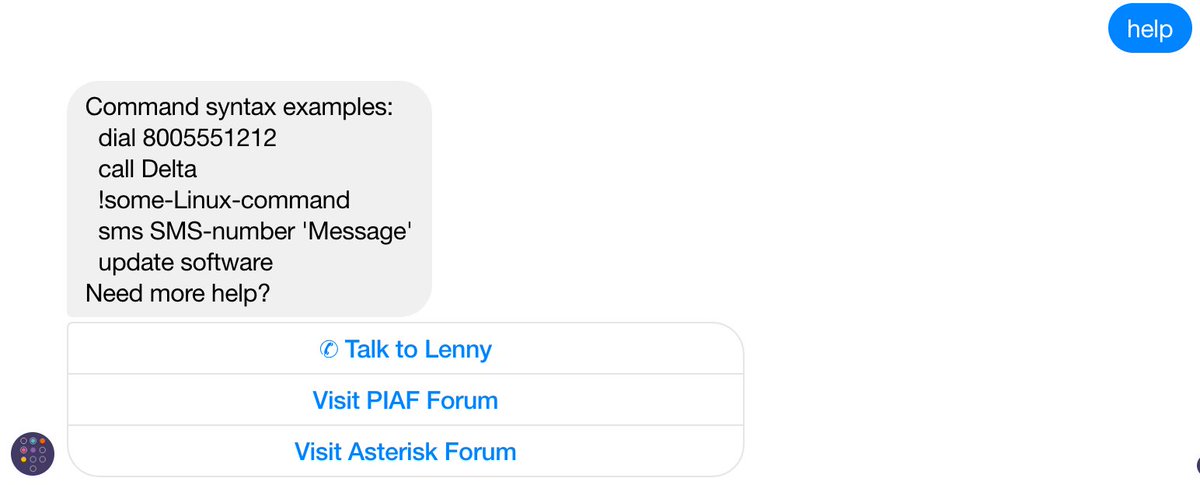
What client-side integration means is the calls use any dialer available on the Messenger client’s platform. They are not sent to your PBX for processing. On a Mac or iPhone, Facetime provides free calls. On Windows, Skype provides paid calls. On Android devices, the Google Hangouts Dialer provides free calls. Facebook basically passes tel: +18005551212 to the client’s browser, and it’s up to the client’s browser to figure out how to process the call. We currently have the feature configured to "Talk to Lenny," but you could change it to Phone Home or Call the Office and enter your own phone number. Here are the commands to do it. Just replace "Phone Home" in the first command below with whatever label desired. Replace "8005551212″ in the second line with the number to be called. Leave the other Lenny entry and phone number as they are since they will be overwritten by these two commands. As noted above, your modifications will be overwritten whenever you execute the update command.
sed -i 's|Talk to Lenny|Phone Home|' /var/www/html/fb/index.php sed -i 's|8436060444|8005551212|' /var/www/html/fb/index.php
Enhanced Calling Option. Beginning with the October 1 update which you can obtain by entering the update command in Messenger, you now have two calling options on some smartphone platforms. The call command still triggers an AsteriDex lookup on your PBX. But now you have a choice in how to place the call. (1) You can click the dial button to place the outbound call through your PBX, or (2) you can click on the retrieved phone number link to place the outbound call using the client-side resource available on your Messenger platform, e.g. Facetime, Skype, or Google Hangouts. In some circumstances, the client-side call may be preferable since it avoids the two-step calling procedure used by Asterisk. The choice is yours and may depend upon the availability and cost of the client-side call when placed from your calling location.
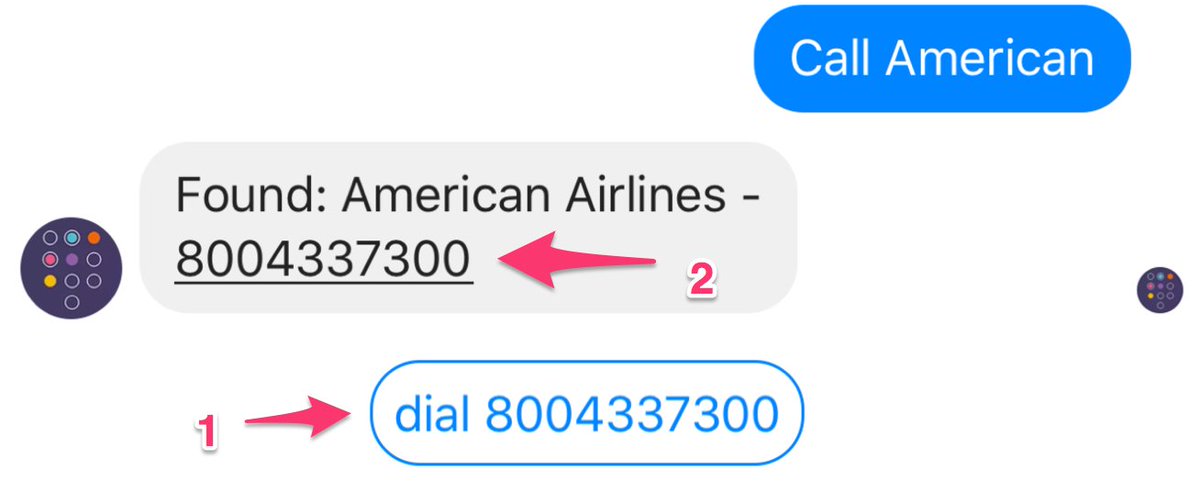
Special Thanks. Our special hat tip to Scott T. Tabor (@ABSGINC) for his pioneering work on Facebook Webhooks. You can visit the PIAF Forum and Scott’s blog to review how far we have come in just two weeks. Thanks, Scott.
Published: Monday, October 2, 2017

Need help with Asterisk? Visit the PBX in a Flash Forum.
Special Thanks to Our Generous Sponsors
FULL DISCLOSURE: ClearlyIP, Skyetel, Vitelity, DigitalOcean, Vultr, VoIP.ms, 3CX, Sangoma, TelecomsXchange and VitalPBX have provided financial support to Nerd Vittles and our open source projects through advertising, referral revenue, and/or merchandise. As an Amazon Associate and Best Buy Affiliate, we also earn from qualifying purchases. We’ve chosen these providers not the other way around. Our decisions are based upon their corporate reputation and the quality of their offerings and pricing. Our recommendations regarding technology are reached without regard to financial compensation except in situations in which comparable products at comparable pricing are available from multiple sources. In this limited case, we support our sponsors because our sponsors support us.
 BOGO Bonaza: Enjoy state-of-the-art VoIP service with a $10 credit and half-price SIP service on up to $500 of Skyetel trunking with free number porting when you fund your Skyetel account. No limits on number of simultaneous calls. Quadruple data center redundancy. $25 monthly minimum spend required. Tutorial and sign up details are here.
BOGO Bonaza: Enjoy state-of-the-art VoIP service with a $10 credit and half-price SIP service on up to $500 of Skyetel trunking with free number porting when you fund your Skyetel account. No limits on number of simultaneous calls. Quadruple data center redundancy. $25 monthly minimum spend required. Tutorial and sign up details are here.
 The lynchpin of Incredible PBX 2020 and beyond is ClearlyIP components which bring management of FreePBX modules and SIP phone integration to a level never before available with any other Asterisk distribution. And now you can configure and reconfigure your new Incredible PBX phones from the convenience of the Incredible PBX GUI.
The lynchpin of Incredible PBX 2020 and beyond is ClearlyIP components which bring management of FreePBX modules and SIP phone integration to a level never before available with any other Asterisk distribution. And now you can configure and reconfigure your new Incredible PBX phones from the convenience of the Incredible PBX GUI.
 VitalPBX is perhaps the fastest-growing PBX offering based upon Asterisk with an installed presence in more than 100 countries worldwide. VitalPBX has generously provided a customized White Label version of Incredible PBX tailored for use with all Incredible PBX and VitalPBX custom applications. Follow this link for a free test drive!
VitalPBX is perhaps the fastest-growing PBX offering based upon Asterisk with an installed presence in more than 100 countries worldwide. VitalPBX has generously provided a customized White Label version of Incredible PBX tailored for use with all Incredible PBX and VitalPBX custom applications. Follow this link for a free test drive!
 Special Thanks to Vitelity. Vitelity is now Voyant Communications and has halted new registrations for the time being. Our special thanks to Vitelity for their unwavering financial support over many years and to the many Nerd Vittles readers who continue to enjoy the benefits of their service offerings. We will keep everyone posted on further developments.
Special Thanks to Vitelity. Vitelity is now Voyant Communications and has halted new registrations for the time being. Our special thanks to Vitelity for their unwavering financial support over many years and to the many Nerd Vittles readers who continue to enjoy the benefits of their service offerings. We will keep everyone posted on further developments.
Some Recent Nerd Vittles Articles of Interest…
VoIP Security: Installing SSL Certificates with Incredible PBX
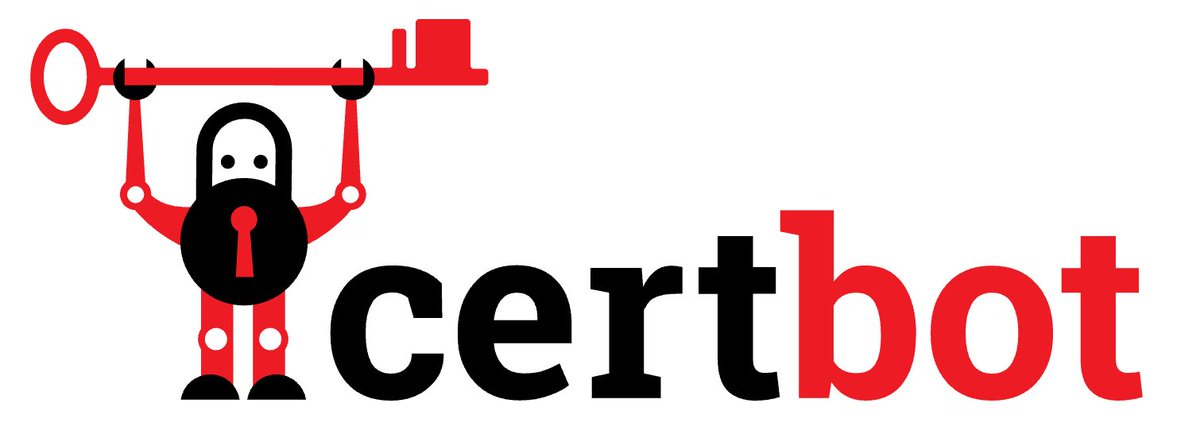
We’ve got some revolutionary VoIP projects coming your way over the next several weeks, but I’m sorry to say the hardest part of them is getting your server configured to use secure and encrypted web communications via HTTPS. This is quickly becoming a universal requirement of most of the major technology players. So what might not be the most glamorous VoIP topic for a Monday morning is not only necessary but long overdue. The good news is that obtaining, installing, configuring, and maintaining an SSL certificate for your VoIP server is not the royal pain that it once was. And, by this time next week, you’ll be glad you went through the exercise. Thankfully, the EFF’s Certbot project is available to assist in installing free certificates from Let’s Encrypt.
Before we begin, here’s a word to the wise. You will save yourself a thousand headaches by deploying your Incredible PBX server in the cloud where you get a dedicated IP address and can easily assign a fully-qualified domain name (FQDN) to your server. Options now are available for as little as $1.50 to $3.50/month including Vultr which provides an incredibly reliable platform in many cities for as little as $2.50 a month. And another 50¢ buys you weekly image backups without lifting a finger. They can be restored with one click! If reliability and redundancy matter, you can’t beat Vultr’s price or the feature set, and we have tutorials to get you started with either Wazo or Issabel. If cost is your sole criteria, you can’t beat WootHosting at $1.50 a month. You’ll find a tutorial here. If performance is critical, you can’t beat OVH at $3.50/month with a Wazo tutorial here and an Issabel tutorial here. Finally, if you’re technically challenged, our corporate sponsor, RentPBX, will do all of the cloud migration for you and provide a turnkey, high performance VoIP platform for just $15/month. So what are you waiting for? Now’s the time. No excuses! It’s not going to get any cheaper or more reliable. And next week you’ll be thanking us. For these reasons, we’re saying goodbye our home-based servers sitting behind NAT-based firewalls. With the projects coming down the pike, the mountain is just too steep to continue that trek unless you have the technical expertise to pull it off yourself.
Obtaining and Installing an SSL Certificate
For CentOS 6 running Incredible PBX 13 or CentOS 7 running Incredible PBX for Issabel 4, begin by making certain that you can access your site using its FQDN with HTTP, e.g. http://myserver.mydomain.org. Get that working first. Next, log into your server as root using SSH/Putty and issue the following commands:
yum -y install python-devel python-pip python-setuptools python-virtualenv --enablerepo=epel yum -y install centos-release-scl yum -y install python27 scl enable python27 bash pip -V # should show python 2.7 pip install --upgrade pip pip install requests registry urllib3 pyOpenSSL --force --upgrade pip install certbot-apache --force --upgrade cd /root wget https://dl.eff.org/certbot-auto chmod a+x certbot-auto service iptables stop ./certbot-auto --authenticator webroot --installer apache -w /var/www/html -d FQDN.here iptables-restart service httpd restart exit
During the automated setup, you can decide whether to force all web traffic to the secure site. We recommend it. Once the install finishes, test access to your server by going to your FQDN using HTTPS. Don’t continue with the setup until you get HTTPS working and your browser shows you have a SECURE site! Remember that you must renew your free certificate every 90 days by using the following /root/certbot-update script:
#!/bin/bash echo "Before you begin, type: scl enable python27 bash" echo "Then rerun this update script and press ENTER." read -p "If you already have done so, press Enter. Otherwise, Ctrl-C now" service iptables stop ./certbot-auto --authenticator webroot --installer apache -w /var/www/html -d FQDN.here iptables-restart echo "Type exit when this script completes." exit
For Debian 8 running Incredible PBX for Wazo, things are a bit more complicated because Wazo forces HTTPS access even though you do not yet have a certificate for your FQDN. Because of its NGINX web server platform, with Wazo you’ll have to manually install and configure certificates with certbot and LetsEncrypt. The silver lining with Wazo is HTTPS access gets you a WebRTC phone with a couple button clicks. Go to this link, click on the Config wheel (bottom right), click on the Pencil icon and plug in the FQDN of your server. Click SAVE. Enter your login name as 701 and the password assigned to the extension which you can obtain by running: /root/show-701-pw. That’s probably the quickest phone setup you’ll ever find. But we’re getting ahead of ourselves…
1. Let’s get certbot installed. Login to your server as root using SSH or Putty and issue the following commands:
cd /etc/apt echo "deb http://ftp.debian.org/debian jessie-backports main" >> sources.list apt-get update apt-get install certbot -t jessie-backports
2. Temporarily, turn off HTTPS since the certificate install requires HTTP access. In /etc/nginx/sites-enabled/xivo, comment out these 3 lines and save the updated file:
In server section for port 80: # include /etc/nginx/locations/http-enabled/*; In server section for port 443: # listen 443 default_server; # server_name $domain;
Then restart the web server: /etc/init.d/nginx restart. Now you have a basic http web server. If you want to verify that it’s working, use a browser and go to http://YOUR-FQDN/asteridex4/index.php. It should download the file to your desktop which isn’t desirable, but this is only temporary.
3. In /var/www/html, issue the following commands:
cd /var/www/html mkdir .well-known cd .well-known mkdir acme-challenge cd acme-challenge chown -R asterisk:www-data /var/www/html/.well-known
Leave this SSH/Putty session running temporarily and open a second SSH/Putty connection to your server logging in as root.
4. Disable your firewall temporarily: /etc/init.d/netfilter-persistent flush
5. Start the certbot installation script: certbot certonly –manual
6. You’ll be prompted for the FQDN of your server to generate the certificates. Then you’ll be given an oddball name AND an expected oddball response. With these two entries in hand, temporarily switch back to your other SSH session and issue these commands while positioned in /var/www/html/.well-known/acme-challenge:
mkdir ODDBALL-NAME cd ODDBALL-NAME echo "ODDBALL-RESPONSE > index.html" chown -R asterisk:www-data /var/www/html/.well-known
7. Use a browser to (quickly) go to http://YOUR-FQDN/.well-known/acme-challenge/ODDBALL-NAME/ and be sure your web server displays the expected ODDBALL-RESPONSE. You’ve got to get this working before you continue with the certbot install or it will fail. You only have a few minutes to do this before certbot will change the ODDBALL-NAME and ODDBALL-RESPONSE credentials. 3 consecutive failures and you have to wait an hour to try again. Guess how we know?
8. Once you get the expected response, switch back to your SSH session running the certbot installer and press ENTER to continue with the certificate install. When it completes, you’ll get a congratulatory note and a reminder that, in less than 90 days, you’ll need to run certbot renew to update your certificate.
9. Install the new certificates in NGINX and put things back together again:
cd /etc/nginx/sites-enabled nano -w xivo
10. Begin by removing the 3 # signs that we inserted to get HTTP working in step #2.
11. Near the bottom of the file, comment out these existing certificate lines:
# ssl_certificate /usr/share/xivo-certs/server.crt; # ssl_certificate_key /usr/share/xivo-certs/server.key; # ssl_ciphers ALL:!aNULL:!eNULL:!LOW:!EXP:!RC4:!3DES:!SEED:+HIGH:+MEDIUM;
12. Add the following new lines just below the lines you commented out. Be sure to replace YOUR.FQDN in each line with the actual FQDN of your server:
ssl_certificate /etc/letsencrypt/live/YOUR.FQDN/fullchain.pem;
ssl_certificate_key /etc/letsencrypt/live/YOUR.FQDN/privkey.pem;
ssl_ciphers HIGH:MEDIUM:!aNULL:!MD5:!SEED:!IDEA;
13. Save the file and then restart your firewall and NGINX:
iptables-restart /etc/init.d/nginx restart
14. Edit /etc/apt/sources.list and comment out the jessie-backports line from step #1.
15. Reload your aptitude sources: apt-get update
16. Remember that you must renew your free certificate every 90 days by issuing this command: certbot renew --quiet.
Better yet, issue the following command to set up a cron job to auto-renew your certificate every week:
echo "5 3 * * 0 root /usr/bin/certbot renew --quiet > /dev/null 2>&1" >> /etc/crontab
17. Test things out with a web browser by visiting your FQDN. Your browser should now show the site as SECURE.
18. Now try out that new WebRTC phone.
Published: Monday, September 25, 2017

Need help with Asterisk? Visit the PBX in a Flash Forum.
Special Thanks to Our Generous Sponsors
FULL DISCLOSURE: ClearlyIP, Skyetel, Vitelity, DigitalOcean, Vultr, VoIP.ms, 3CX, Sangoma, TelecomsXchange and VitalPBX have provided financial support to Nerd Vittles and our open source projects through advertising, referral revenue, and/or merchandise. As an Amazon Associate and Best Buy Affiliate, we also earn from qualifying purchases. We’ve chosen these providers not the other way around. Our decisions are based upon their corporate reputation and the quality of their offerings and pricing. Our recommendations regarding technology are reached without regard to financial compensation except in situations in which comparable products at comparable pricing are available from multiple sources. In this limited case, we support our sponsors because our sponsors support us.
 BOGO Bonaza: Enjoy state-of-the-art VoIP service with a $10 credit and half-price SIP service on up to $500 of Skyetel trunking with free number porting when you fund your Skyetel account. No limits on number of simultaneous calls. Quadruple data center redundancy. $25 monthly minimum spend required. Tutorial and sign up details are here.
BOGO Bonaza: Enjoy state-of-the-art VoIP service with a $10 credit and half-price SIP service on up to $500 of Skyetel trunking with free number porting when you fund your Skyetel account. No limits on number of simultaneous calls. Quadruple data center redundancy. $25 monthly minimum spend required. Tutorial and sign up details are here.
 The lynchpin of Incredible PBX 2020 and beyond is ClearlyIP components which bring management of FreePBX modules and SIP phone integration to a level never before available with any other Asterisk distribution. And now you can configure and reconfigure your new Incredible PBX phones from the convenience of the Incredible PBX GUI.
The lynchpin of Incredible PBX 2020 and beyond is ClearlyIP components which bring management of FreePBX modules and SIP phone integration to a level never before available with any other Asterisk distribution. And now you can configure and reconfigure your new Incredible PBX phones from the convenience of the Incredible PBX GUI.
 VitalPBX is perhaps the fastest-growing PBX offering based upon Asterisk with an installed presence in more than 100 countries worldwide. VitalPBX has generously provided a customized White Label version of Incredible PBX tailored for use with all Incredible PBX and VitalPBX custom applications. Follow this link for a free test drive!
VitalPBX is perhaps the fastest-growing PBX offering based upon Asterisk with an installed presence in more than 100 countries worldwide. VitalPBX has generously provided a customized White Label version of Incredible PBX tailored for use with all Incredible PBX and VitalPBX custom applications. Follow this link for a free test drive!
 Special Thanks to Vitelity. Vitelity is now Voyant Communications and has halted new registrations for the time being. Our special thanks to Vitelity for their unwavering financial support over many years and to the many Nerd Vittles readers who continue to enjoy the benefits of their service offerings. We will keep everyone posted on further developments.
Special Thanks to Vitelity. Vitelity is now Voyant Communications and has halted new registrations for the time being. Our special thanks to Vitelity for their unwavering financial support over many years and to the many Nerd Vittles readers who continue to enjoy the benefits of their service offerings. We will keep everyone posted on further developments.
Some Recent Nerd Vittles Articles of Interest…
Twofer Tuesday: Incredible PBX 13 to the Rescue

With the Digium announcement last week that four and a half year’s worth of Asterisk® servers were vulnerable to the RTP eavesdropping bug, it prompted us to dust off our Incredible PBX® 13 for CentOS build and bring it up to current specs including the Digium patch for RTPbleed. And then along came Hurricane Issabel to remind us that sh*t happens, and it pays to have a backup plan for your telecommunications infrastructure. So today we’re pleased to introduce two new Asterisk solutions: a cloud-based server for $1 a month and a VirtualBox image that will run on any Windows or Mac computer. We would stress that these should be part of a comprehensive backup plan and may not be suitable to implement as your primary communications platform. But, for those impacted by Harvey’s or Issabel’s devastation, either of today’s solutions will get you a very stable PBX platform as soon as you have Internet or cellular connectivity.
Cloud Hosting for $1/month in NYC, Miami or LA
For today’s emergency cloud platform, we’ve chosen WootHosting which provides a rock-solid VPS in your choice of locations starting at $12 a year. That buys you the following:
2 CPU Core Allocations
1024MB Dedicated RAM
1024MB vSwap
50GB Secured Disk Space
3000GB Premium Bandwidth
1 IPv4 Address
100Mbps Port Speed
Choose New York Grand Opening Specials under the left tab. You still get your choice of cities for the $12/year VPS! Just configure the VPS as a CentOS 6, 64-bit platform. Login to the server as root using SSH or Putty and issue these commands:
setenforce 0 yum -y install net-tools nano wget tar yum -y upgrade --skip-broken wget http://incrediblepbx.com/incrediblepbx13-12.2-centos.tar.gz tar zxvf incrediblepbx* ./create-swapfile-DO ./IncrediblePBX*
On some platforms (not WootHosting’s VPS), your server may automatically reboot midway through the install. On these platforms, log back in as root and run the installer a second time to complete the install:
./IncrediblePBX*
After restarting the server at the conclusion of the install, log back in as root and perform the following steps to complete your setup:
Make your root password very secure: passwd
Create admin password for GUI access: /root/admin-pw-change
Set your correct time zone: /root/timezone-setup
Create admin password for web apps: htpasswd /etc/pbx/wwwpasswd admin
Make a copy of your Knock codes: cat /root/knock.FAQ
Decipher your Reminders password: cat /root/reminders.FAQ
InsertOPTIONS="-i venet0:0"in /etc/sysconfig/knockd
Decipher IP address and other info about your server: status
Your server will be up and running in about an hour. Remember, we are compiling all of the components including Asterisk from source which means customization and updates are easy. Continue your adventure by following our previous tutorial.
Incredible PBX 13 with VirtualBox in Under 5 Minutes
If you’re in a time crunch or prefer to set up a PBX locally, there is no better solution than VirtualBox. It runs on any desktop PC, Mac, Linux or Solaris machine, and the new Incredible PBX 13 image for VirtualBox can be installed and configured in under 5 minutes. With a single button click, you can backup your entire PBX in a couple of minutes and save it for a rainy day.
Today’s release is built atop the CentOS 6.9 platform and features the latest release of Asterisk 13 and a terrific collection of GPL modules from FreePBX® 12. Think of Incredible PBX as the glue stick that assembles all the necessary VoIP components and holds them together seamlessly. As with all Incredible PBX builds, you also get the full complement of goodies including dozens of text-to-speech apps, voice recognition and dialing, SMS messaging, Google Voice and free fax support, reminders and wakeup calls, and SECURITY!
Is VirtualBox merely a sandbox for experimentation? Absolutely not. With any of the beefier desktop computers available today, running Incredible PBX as a 24/7 VirtualBox image is every bit as feature rich with stellar performance that’s equivalent to using dedicated hardware. And there are some added advantages. Obviously, deploying a turnkey VoIP platform in under 5 minutes is a major plus. But, unlike using a dedicated Linux platform, you also get the ability to take snapshots of your system and do full backups in minutes instead of the hours required to bring down dedicated hardware, load a different backup application using a different operating system, perform a backup, and then reboot your VoIP server. And your backups won’t just run on the one server on which the backup was performed. You can restore the backup to any other computer that can run VirtualBox. For any of you that came from a network management background, you know what a big deal that really is. And there’s one more bonus. With Incredible Backup and Restore, you can move your image to dedicated hardware running the same operating system with Asterisk 13 and the same GUI platform in minutes.
Are there security compromises using the VirtualBox platform? Not at all. Incredible PBX still comes preconfigured with the Linux IPtables firewall that is locked down to a whitelist of local area networks, preferred providers, and your own IP addresses. You can expand the whitelist using the add-ip and add-fqdn scripts or use PortKnocker and Travelin’ Man 4 tools to let remote users gain instant access.
Getting Started with VirtualBox. Step #1 today is to download one or more of the 64-bit VirtualBox installers from VirtualBox.org or Oracle.com. Our recommendation is to put all of the 100MB installers on a 4GB thumb drive.1 Then you’ll have everything in one place whenever and wherever you happen to need it. Once you’ve downloaded the software, simply install it onto your favorite desktop machine. Accept all of the default settings, and you’ll be good to go. And here’s a link to the latest Oracle VM VirtualBox User Manual.
Downloading the Incredible PBX 13 Virtual Machine. A word of warning on the front end. The new Incredible PBX image featuring Asterisk 13 for VirtualBox is huge, about 2.3GB! Download the image from SourceForge onto your desktop by clicking here.
Importing Incredible PBX 13 into VirtualBox. Double-click on the .ova file you downloaded to begin the import procedure and load it into VirtualBox. When prompted, be sure to check the Reinitialize the Mac address of all network cards box and then click the Import button. Once the import is finished, you’ll see a new Incredible PBX 13 for CentOS 6.9 virtual machine in your VM List on the VirtualBox Manager Window. We need to make a couple of one-time adjustments to the Incredible PBX VM configuration to account for differences in sound and network cards on different host machines.
Click on the Incredible PBX Virtual Machine in the VM List. Then click Settings -> Audio. Verify that Enable Audio option is checked and choose your sound card. Then click OK. Next click Settings -> Network. For Adapter 1, be sure the Enable Network Adapter option is checked. From the Attached to pull-down menu, choose Bridged Adapter. Then select your network card from the Name list. Then click OK. That’s all the configuration that is necessary for your Incredible PBX Virtual Machine.
Running Incredible PBX 13 on VirtualBox. Once you’ve imported and configured the Incredible PBX Virtual Machine, you’re ready to go. Highlight Incredible PBX 13 for CentOS 6.9 Virtual Machine in the VM List on the VirtualBox Manager Window and click the Start button. The CentOS 6.9 boot procedure will begin just as if you had installed Incredible PBX on a standalone machine. You’ll see a couple of dialogue boxes pop up that explain the keystrokes to move back and forth between your host operating system desktop and your virtual machine. Remember, you still have full access to your desktop computer. Incredible PBX is merely running as a task in a VirtualBox window. Always gracefully halt Incredible PBX just as you would on a dedicated computer.
Here’s what you need to know. To work in the Incredible PBX Virtual Machine, just left-click your mouse while it is positioned inside the VM window. To return to your host operating system desktop, press the right Option key on Windows machines or the left Command key on any Mac. For other operating systems, read the dialogue boxes for instructions on moving around. To access the Linux CLI, login as root with the default password: password.
When logging in for the first time, Incredible PBX will go through some setup steps and then reboot. Login again to complete the setup. status will always provide a snapshot of your system. To shut down Incredible PBX gracefully, click in the VM window with your mouse, log in as root, and type: halt. Be sure to complete the following setup steps from the Linux CLI:
- Change your root password: passwd
- Set your FreePBX admin password: /root/admin-pw-change
- Set your web apps admin password: htpasswd /etc/pbx/wwwpasswd admin
- Set your correct time zone: /root/timezone-setup
- Add WhiteList entries to firewall if needed: /root/add-ip or /root/add-fqdn
- Store PortKnocker credentials in a safe place: cat /root/knock.FAQ
- Decipher your Reminders password: cat /root/reminders.FAQ
- Login to your NeoRouter VPN server if desired: /root/nrclientcmd
To access the Incredible PBX GUI with a browser, point to the IP address of your virtual machine and login as admin with admin password set above. We recommend that you log in to the Linux CLI as root at least once a week so that Incredible PBX updates get applied to your server regularly. This is critically important if you care about your phone bill. Enjoy!
Published: Tuesday, September 12, 2017

Need help with Asterisk? Visit the PBX in a Flash Forum.
Special Thanks to Our Generous Sponsors
FULL DISCLOSURE: ClearlyIP, Skyetel, Vitelity, DigitalOcean, Vultr, VoIP.ms, 3CX, Sangoma, TelecomsXchange and VitalPBX have provided financial support to Nerd Vittles and our open source projects through advertising, referral revenue, and/or merchandise. As an Amazon Associate and Best Buy Affiliate, we also earn from qualifying purchases. We’ve chosen these providers not the other way around. Our decisions are based upon their corporate reputation and the quality of their offerings and pricing. Our recommendations regarding technology are reached without regard to financial compensation except in situations in which comparable products at comparable pricing are available from multiple sources. In this limited case, we support our sponsors because our sponsors support us.
 BOGO Bonaza: Enjoy state-of-the-art VoIP service with a $10 credit and half-price SIP service on up to $500 of Skyetel trunking with free number porting when you fund your Skyetel account. No limits on number of simultaneous calls. Quadruple data center redundancy. $25 monthly minimum spend required. Tutorial and sign up details are here.
BOGO Bonaza: Enjoy state-of-the-art VoIP service with a $10 credit and half-price SIP service on up to $500 of Skyetel trunking with free number porting when you fund your Skyetel account. No limits on number of simultaneous calls. Quadruple data center redundancy. $25 monthly minimum spend required. Tutorial and sign up details are here.
 The lynchpin of Incredible PBX 2020 and beyond is ClearlyIP components which bring management of FreePBX modules and SIP phone integration to a level never before available with any other Asterisk distribution. And now you can configure and reconfigure your new Incredible PBX phones from the convenience of the Incredible PBX GUI.
The lynchpin of Incredible PBX 2020 and beyond is ClearlyIP components which bring management of FreePBX modules and SIP phone integration to a level never before available with any other Asterisk distribution. And now you can configure and reconfigure your new Incredible PBX phones from the convenience of the Incredible PBX GUI.
 VitalPBX is perhaps the fastest-growing PBX offering based upon Asterisk with an installed presence in more than 100 countries worldwide. VitalPBX has generously provided a customized White Label version of Incredible PBX tailored for use with all Incredible PBX and VitalPBX custom applications. Follow this link for a free test drive!
VitalPBX is perhaps the fastest-growing PBX offering based upon Asterisk with an installed presence in more than 100 countries worldwide. VitalPBX has generously provided a customized White Label version of Incredible PBX tailored for use with all Incredible PBX and VitalPBX custom applications. Follow this link for a free test drive!
 Special Thanks to Vitelity. Vitelity is now Voyant Communications and has halted new registrations for the time being. Our special thanks to Vitelity for their unwavering financial support over many years and to the many Nerd Vittles readers who continue to enjoy the benefits of their service offerings. We will keep everyone posted on further developments.
Special Thanks to Vitelity. Vitelity is now Voyant Communications and has halted new registrations for the time being. Our special thanks to Vitelity for their unwavering financial support over many years and to the many Nerd Vittles readers who continue to enjoy the benefits of their service offerings. We will keep everyone posted on further developments.
Some Recent Nerd Vittles Articles of Interest…
RTPbleed Security Alert: Asterisk Calls Can Be Intercepted

If you’ve installed Asterisk® during the past 4½ years, your server has a MAJOR security problem. If you didn’t already know, with Asterisk, your VoIP conversations actually are carried over a random UDP port using the Real Time Protocol (RTP), not the SIP port (UDP 5060) which handles the setup and teardown of your VoIP connections. It turns out that, since March 2013, all of that RTP traffic and thus your conversations could be intercepted and redirected by anyone on the Internet. As this recent article in The Register noted:
The problem occurs when [communications] systems like IP telephony have to get past network address translation (NAT) firewalls. The traffic has to find its way from the firewall’s public IP address to the internal address of the device or server, and to do that, RTP learns the IP and port addresses to associate with a call.
The problem is, the process doesn’t use any kind of authentication.
This is exacerbated by the fact that, by default, Asterisk and FreePBX® traditionally use the NAT=yes setting (whether needed or not) to enable this navigational magic just in case your calls need it. Without it, you may end up with no audio or one-way audio on your calls. Traditional wisdom was that an attacker needed to be positioned between the caller and the Asterisk server in order to intercept this media stream. As luck would have it, it turns out the man in the middle didn’t need to be in the middle after all. He could be anywhere on the Internet. The old adage to talk on the phone as if someone else were listening turns out to have been pretty good advice in the case of Asterisk communications. Even if you had a firewall, chances are you protected UDP port 5060 while exposing and forwarding UDP 10000-20000 to Asterisk without any safeguards.
According to last week’s Asterisk advisory, “To exploit this issue, an attacker needs to send RTP packets to the Asterisk server on one of the ports allocated to receive RTP. When the target is vulnerable, the RTP proxy responds back to the attacker with RTP packets relayed from the other party. The payload of the RTP packets can then be decoded into audio.” Specifically, if UDP ports 10000-20000 are publicly exposed to the Internet, anybody and everybody can intercept your communications without credentials of any kind. WOW!
So, there’s a patch to fix this, right? Well, not exactly:
Note that as for the time of writing, the official Asterisk fix is vulnerable to a race condition. An attacker may continuously spray an Asterisk server with RTP packets. This allows the attacker to send RTP within those first few packets and still exploit this vulnerability.
The other recommended "solutions" aren’t much better:
- When possible the nat=yes option should be avoided
- To protect against RTP injection, encrypt media streams with SRTP
- Add config option for SIP peers to prioritize RTP packets
The nat=no option doesn’t work if you or your provider employs NAT-based routers. The SRTP option only works on more recent releases of Asterisk, and it also requires SRTP support on every SIP phone. Prioritizing RTP packets is not a task for mere mortals.
Surprisingly, the one solution that is not even mentioned is hardening your firewall to block incoming UDP 10000-20000 traffic that originates outside your server. Our recognized SIP expert on the PIAF Forum had the simple solution. Bill Simon observed:
If the SDP in the INVITE or subsequent re-INVITE contains routable IP addresses, then use them for media. If the SDP contains non-routable IP addresses, then the client is behind a NAT and not using any NAT traversal techniques like SIP ALG, ICE/STUN, so send to the originating IP. Why are we making allowances here for media to come from anywhere? I think you can probably clamp down your firewall as much as you want, because symmetric RTP should allow media to get through by way of establishing an outbound stream (inbound stream comes back on the same path).
Our testing confirms that simply blocking incoming RTP traffic on your firewall solves the problem without any Asterisk patch. In short, RTP traffic cannot originate from anonymous sources on the Internet.
For those using Incredible PBX® or Travelin’ Man 3 or an IPtables firewall, the fix is easy. Simply remove or comment out the INPUT rule that looks like this and restart IPtables:
-A INPUT -p udp -m udp --dport 10000:20000 -j ACCEPT
On RedHat/CentOS servers, the rule is in /etc/sysconfig/iptables. On Debian/Ubuntu and Raspbian servers, you’ll find the rule in /etc/iptables/rules.v4. On Incredible PBX for Issabel servers, you’ll find the rule in /usr/local/sbin/iptables-custom. On all Incredible PBX platforms, remember to restart IPtables using only this command: iptables-restart.
Published: Friday, September 8, 2017

Need help with Asterisk? Visit the PBX in a Flash Forum.
Special Thanks to Our Generous Sponsors
FULL DISCLOSURE: ClearlyIP, Skyetel, Vitelity, DigitalOcean, Vultr, VoIP.ms, 3CX, Sangoma, TelecomsXchange and VitalPBX have provided financial support to Nerd Vittles and our open source projects through advertising, referral revenue, and/or merchandise. As an Amazon Associate and Best Buy Affiliate, we also earn from qualifying purchases. We’ve chosen these providers not the other way around. Our decisions are based upon their corporate reputation and the quality of their offerings and pricing. Our recommendations regarding technology are reached without regard to financial compensation except in situations in which comparable products at comparable pricing are available from multiple sources. In this limited case, we support our sponsors because our sponsors support us.
 BOGO Bonaza: Enjoy state-of-the-art VoIP service with a $10 credit and half-price SIP service on up to $500 of Skyetel trunking with free number porting when you fund your Skyetel account. No limits on number of simultaneous calls. Quadruple data center redundancy. $25 monthly minimum spend required. Tutorial and sign up details are here.
BOGO Bonaza: Enjoy state-of-the-art VoIP service with a $10 credit and half-price SIP service on up to $500 of Skyetel trunking with free number porting when you fund your Skyetel account. No limits on number of simultaneous calls. Quadruple data center redundancy. $25 monthly minimum spend required. Tutorial and sign up details are here.
 The lynchpin of Incredible PBX 2020 and beyond is ClearlyIP components which bring management of FreePBX modules and SIP phone integration to a level never before available with any other Asterisk distribution. And now you can configure and reconfigure your new Incredible PBX phones from the convenience of the Incredible PBX GUI.
The lynchpin of Incredible PBX 2020 and beyond is ClearlyIP components which bring management of FreePBX modules and SIP phone integration to a level never before available with any other Asterisk distribution. And now you can configure and reconfigure your new Incredible PBX phones from the convenience of the Incredible PBX GUI.
 VitalPBX is perhaps the fastest-growing PBX offering based upon Asterisk with an installed presence in more than 100 countries worldwide. VitalPBX has generously provided a customized White Label version of Incredible PBX tailored for use with all Incredible PBX and VitalPBX custom applications. Follow this link for a free test drive!
VitalPBX is perhaps the fastest-growing PBX offering based upon Asterisk with an installed presence in more than 100 countries worldwide. VitalPBX has generously provided a customized White Label version of Incredible PBX tailored for use with all Incredible PBX and VitalPBX custom applications. Follow this link for a free test drive!
 Special Thanks to Vitelity. Vitelity is now Voyant Communications and has halted new registrations for the time being. Our special thanks to Vitelity for their unwavering financial support over many years and to the many Nerd Vittles readers who continue to enjoy the benefits of their service offerings. We will keep everyone posted on further developments.
Special Thanks to Vitelity. Vitelity is now Voyant Communications and has halted new registrations for the time being. Our special thanks to Vitelity for their unwavering financial support over many years and to the many Nerd Vittles readers who continue to enjoy the benefits of their service offerings. We will keep everyone posted on further developments.
Some Recent Nerd Vittles Articles of Interest…
Another Perfect Pair: Flawless VoIP with Wazo and 3CX

We previously documented how to interconnect an Issabel PBX with 3CX to take advantage of the best of both worlds. Today, we’ll again use the Nerd Vittles free 3CX server offering and interconnect it with a Wazo PBX. An added benefit of using Wazo is the fact that you can set up redundant (and free) HA servers with Wazo in minutes. Once we get the pieces in place, from Wazo extensions, you’ll be able to call your 3CX Clients by dialing 4 digits. And, from 3CX Clients, you can call Wazo extensions as well as all of your Asterisk® applications in the same way with the added bonus of being able to make outbound calls through your Wazo trunks by dialing any number with an 8 prefix from 3CX extensions. Once you have both of your PBXs running, the setup time to interconnect them is under 5 minutes.
Why would you want to maintain two PBXs? As we previously noted, the simple answer is the added flexibility you achieve coupled with a 99% reduction in VoIP headaches. If you haven’t yet used 3CX Clients on a PC or Mac desktop or on an iOS or Android device, you have missed perhaps the greatest VoIP advancement of the last decade. As the name suggests 3CX Clients connect to a 3CX server with less than a one-minute setup. They work flawlessly from anywhere using WiFi or cellular. Every function you’re accustomed to on a top-of-the-line desktop SIP phone works exactly the same on the 3CX clients: phonebook, hold, transfer, voicemail, chat, conferencing, and WebMeeting. It’s what every Unified Communications system should deliver. The silver lining is you can kiss all of your Asterisk NAT woes goodbye! If you ever travel or if you need remote phone access to your PBX infrastructure, you owe it to yourself to try a 3CX Client. We promise. You’ll never go back!
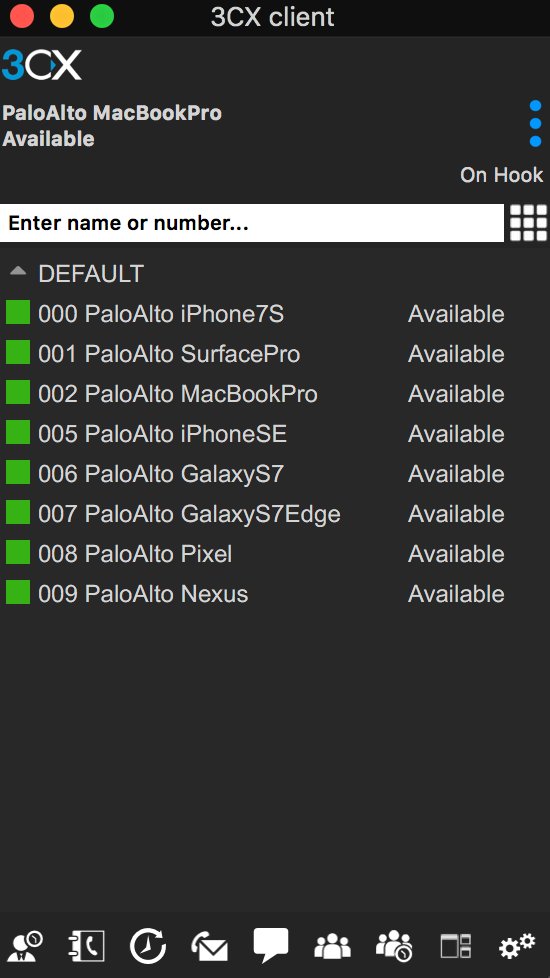
Building Your Wazo and 3CX Server Platforms
The prerequisite for interconnecting Wazo and 3CX servers is, of course, to install the two PBXs on platforms of your choice. Our preference is cloud-based servers because it avoids many of the stumbling blocks with NAT-based routers. If you know what you’re doing, you obviously can deploy the PBXs in any way you like. For the Wazo PBX, start with our latest Wazo tutorial. For 3CX, start with our introductory tutorial which includes a link to obtain a free perpetual license supporting 4 simultaneous calls and unlimited trunks. Then secure your server by adding the Travelin’ Man 3 firewall for 3CX. Once both servers are up and running, whitelist the IP address or FQDN of the Wazo PBX on the 3CX server and vice versa. You’ll find the add-ip and add-fqdn utilities in /root of each server.
Overview of Interconnection Methodology
If you’re new to all of this, suffice it to say that 3CX is a powerful, commercial PBX while Wazo provides a robust Asterisk RealTime implementation for basic telephony operation. The two systems are quite different in terms of their approaches to interconnectivity. While you can transparently interconnect one 3CX server to another one, you cannot accomplish the same thing when the second PBX is Asterisk-based. Instead, Wazo is configured as a SIP trunk on the 3CX platform. The limitation this causes is that extensions on the Wazo PBX can only direct dial extensions on the 3CX platform. Wazo-based extensions cannot utilize 3CX trunks to place outbound calls. There’s more flexibility on the 3CX side of things. 3CX extensions can place direct calls to Wazo extensions. They also can take advantage of Wazo’s trunks to place outbound calls. Additionally, as we noted above, 3CX extensions can take advantage of every Asterisk application hosted on the Wazo platform including all of the Incredible PBX® enhancements. This actually works out perfectly because you can deploy 3CX Clients for your end-users, and they can take advantage of all the extension and trunk resources on both the 3CX and Wazo platforms. It also greatly simplifies remote deployment by removing NAT one-way audio hassles while allowing almost instantaneous setup of remote 3CX Clients, even by end-users.
For our setup today, we’re assuming you have elected to use 3-digit extensions on both the Wazo and 3CX platforms. To call extensions connected directly to the alternate server, we will simply dial 8 + the extension number on the remote PBX. To make external calls from 3CX extensions using Wazo trunks, we will dial 8 + a 10-digit number. For international users, you can adjust the dialplan on both PBXs accordingly.
By default, SIP trunks are associated with a DID on the 3CX platform. We will register the 3CX DID trunk with Wazo to maintain connectivity; however, we will not register the corresponding trunk on the Wazo side with the 3CX server. Keep in mind that you can only route a 3CX DID to a single destination, i.e. an extension, a ring group, or an IVR. But we can use 3CX’s CallerID routing feature to send calls to specific 3CX extensions from Wazo extensions even using a single 3CX trunk. For each 3CX extension, we’ll create an Outbound Route on the Wazo side with a CallerID number that matches the 3CX extension number we wish to reach. On the 3CX side, we’ll create an Inbound CID Rule that specifies the extension number to which each matching CallerID number should be routed. This sounds harder than it actually is. So keep reading, and it’ll all make sense momentarily. Once you’ve set all of this up, we think you’ll agree that it makes sense to create the bulk of your extensions exclusively on the 3CX side.
Configuring Wazo for Interconnection to 3CX
Let’s begin by creating a Trunk on the Wazo side to connect to your 3CX server. In the Wazo GUI, choose IPBX:Trunk Management:SIP Protocol and + Add SIP Trunk.
In the General tab, fill in the blanks as shown below. Make up a very secure Password:
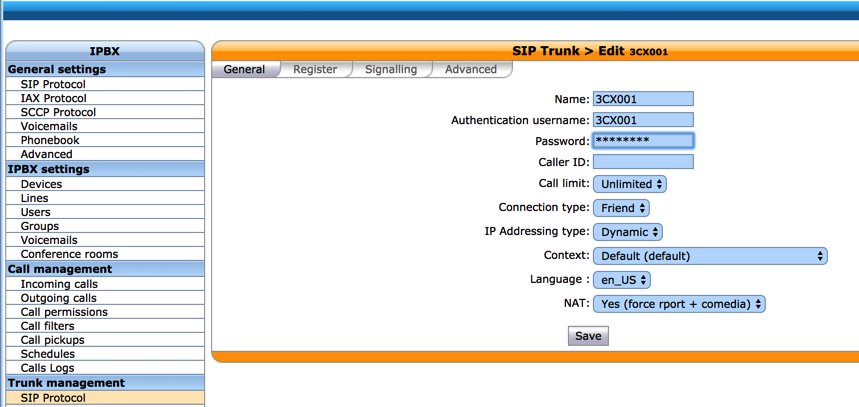
In the Signalling tab, fill in the blanks identified by arrows as shown below:
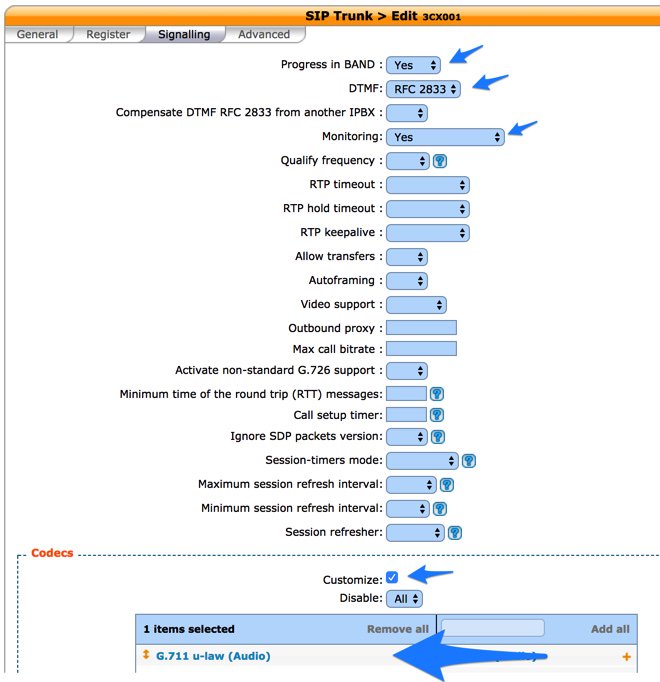
In the Advanced tab, fill in the blanks as shown below. Then SAVE the trunk settings.

Because we set up the Wazo trunk with a Default destination context, we don’t need an Incoming Route for the 3CX calls since they will be processed exactly as if they were dialed from a local extension on the Wazo PBX, i.e. local calls will be routed to extensions and outgoing calls through trunks will be routed using your existing Outbound Routes.
Finally, we need to create the Outbound Routes for calls originating from Wazo extensions that should be directed to specific extensions on the 3CX platform. You’ll need a list of the 3CX extension numbers you wish to enable on the Wazo platform, and we’ll need to create a separate Outbound Route for each 3CX extension to be enabled. Create the Outbound Routes using the template below after accessing Call Management:Outgoing Calls:+ Add Route.
In the General tab, we recommend including the 3CX extension in the Name field. The Context should be Outcalls, and the Trunk should be the 3CX001 trunk we created above.

In the Exten tab, specify the dialing prefix (9) followed by the 3CX extension number in the Exten field. Then choose 1 in the Stripnum field to tell Wazo to strip off the dialing prefix before sending the call to the 3CX PBX. Click SAVE to save your new outbound route settings. Repeat for each 3CX extension that should be accessible from the Wazo PBX.
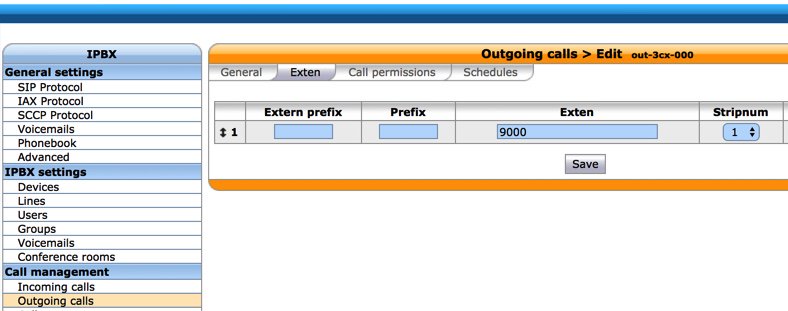
Configuring 3CX for Interconnection to Issabel PBX
Now we’re ready to set up the 3CX side to interconnect with your Wazo PBX. Start by creating a SIP Trunk and fill out the template as shown below using one of the phone numbers associated with your Wazo PBX as the Main Trunk No.
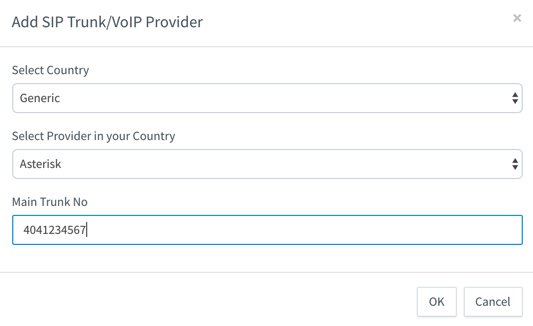
Fill in the Trunk Details using the example below. Be sure to specify the actual IP address or FQDN of your Wazo server as well as the SIP credentials of 3CX for username and the actual password you set up on the Wazo side of things. The Main Trunk No will be the same as you entered in the previous step. Choose a Default Destination for the Trunk.
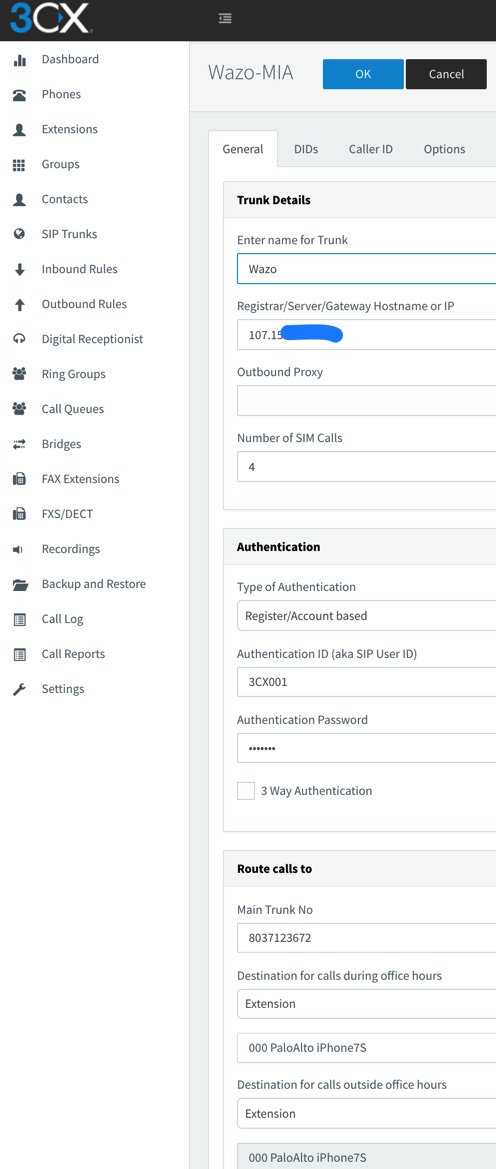
When the SIP Trunks listing redisplays, highlight your new Asterisk trunk and click Refresh Registration. The icon beside the Trunk should turn green. If not, be sure your IP address and password match the settings on the Wazo side. Remember to also whitelist the IP address of your 3CX server on the Wazo PBX using /root/add-ip and do the same for the Wazo PBX on the 3CX side. Don’t proceed until you get a green light!
Now we need two Outbound Routes for calls placed from 3CX extensions. One will handle calls destined for Local Extensions on the Wazo side. Our design is to place calls to Wazo extensions by dialing 8 + the 3-digit extension number. Adjust this to meet your own requirements. Be sure to set the Route as Wazo with a value of 1 for Strip Digits.
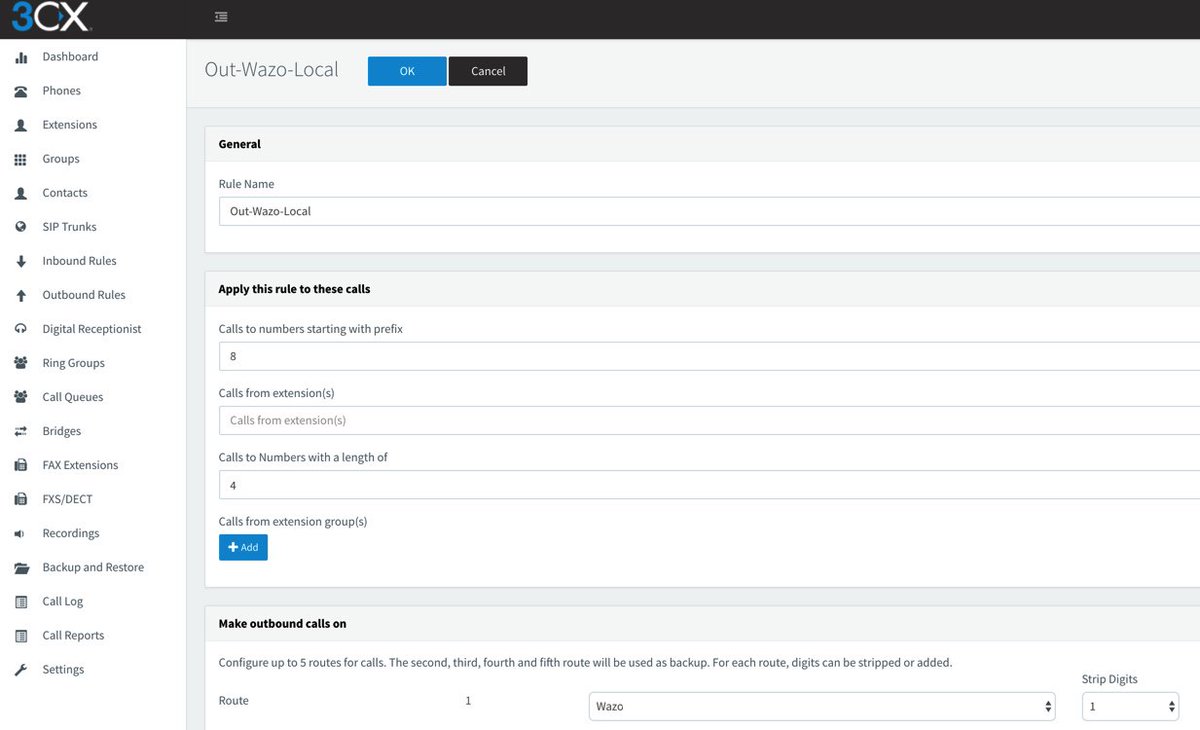
The other Outbound Route will handle calls destined for external calling with a Wazo trunk using a similar methodology. 3CX users will dial 8 + 10-digit number for calls to be processed by Trunks on the Wazo server.
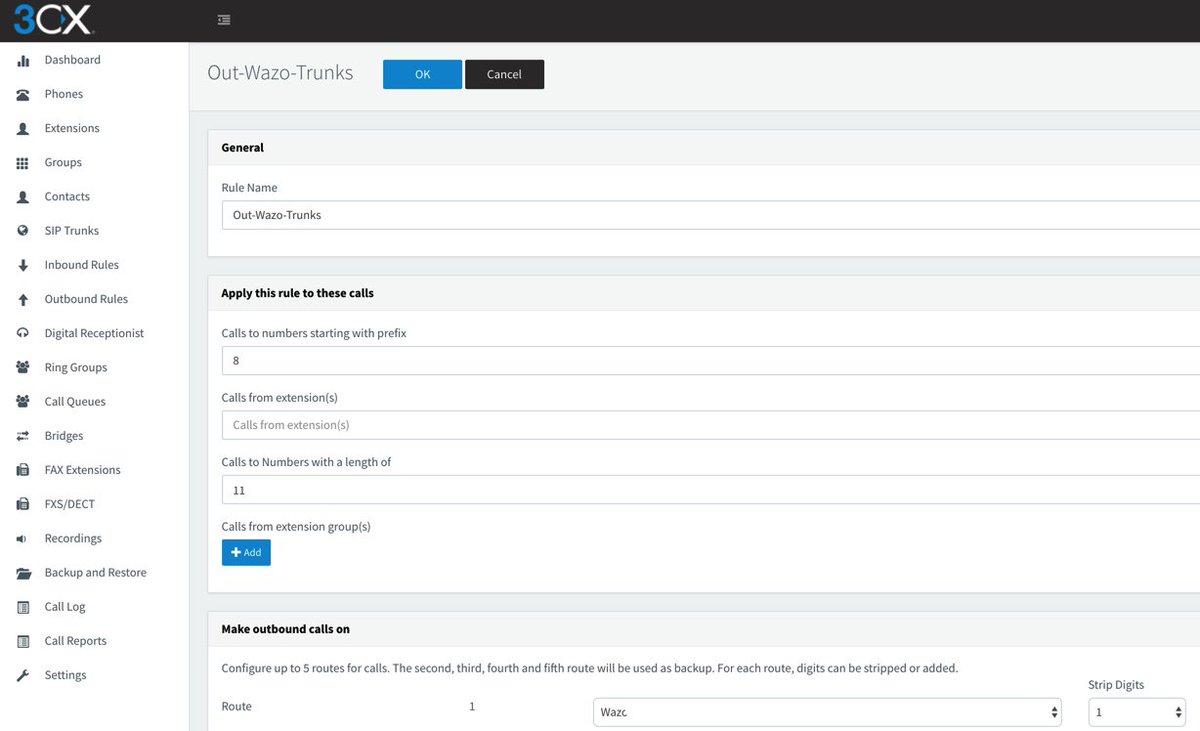
Finally, we need an Inbound Rule for every 3CX extension that you wish to enable for remote calling from Wazo extensions. Use the Add CID Rule option to create each Inbound Rule using the sample below. In our example, we’re authorizing incoming calls to 3CX extension 003 where the CallerID number of the incoming call is 003. This template is exactly the same as what we used with the 3CX-Issabel setup previously.
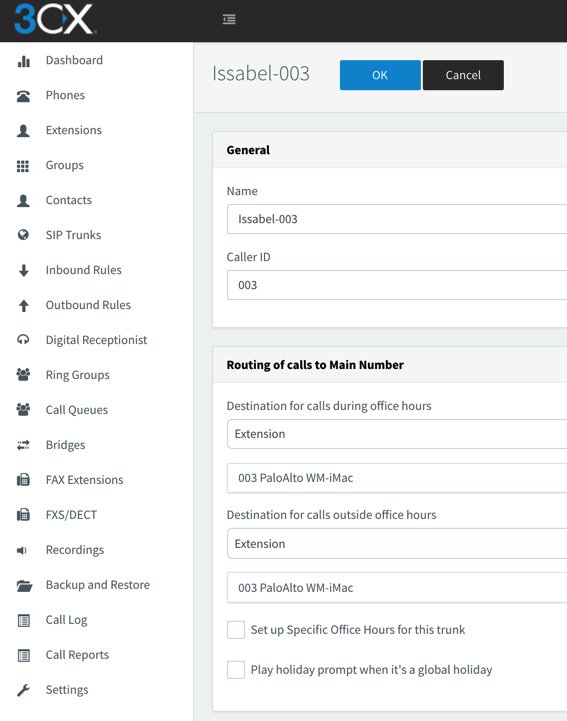
Test Drive Your Interconnected Servers
Now we’re ready to try things out. From an extension on the 3CX server, dial 8 plus any 3-digit extension that exists on the Wazo server. Next, dial 8 plus a 10-digit number such as your smartphone. The call should be routed out of your Wazo server using the Trunk associated with the NXXNXXXXXX rule in your Wazo Outbound Routes. Finally, from an extension on your Wazo PBX, dial 9 plus 000 which should route the call to extension 000 on your 3CX server. Enjoy!
Published: Tuesday, September 5, 2017
 Support Issues. With any application as sophisticated as this one, you’re bound to have questions. Blog comments are a difficult place to address support issues although we welcome general comments about our articles and software. If you have particular support issues, we encourage you to get actively involved in the PBX in a Flash Forum. It’s the best Asterisk tech support site in the business, and it’s all free! Please have a look and post your support questions there. Unlike some forums, the PIAF Forum is extremely friendly and is supported by literally hundreds of Asterisk gurus and thousands of users just like you. You won’t have to wait long for an answer to your question.
Support Issues. With any application as sophisticated as this one, you’re bound to have questions. Blog comments are a difficult place to address support issues although we welcome general comments about our articles and software. If you have particular support issues, we encourage you to get actively involved in the PBX in a Flash Forum. It’s the best Asterisk tech support site in the business, and it’s all free! Please have a look and post your support questions there. Unlike some forums, the PIAF Forum is extremely friendly and is supported by literally hundreds of Asterisk gurus and thousands of users just like you. You won’t have to wait long for an answer to your question.

Need help with Asterisk? Visit the PBX in a Flash Forum.
Special Thanks to Our Generous Sponsors
FULL DISCLOSURE: ClearlyIP, Skyetel, Vitelity, DigitalOcean, Vultr, VoIP.ms, 3CX, Sangoma, TelecomsXchange and VitalPBX have provided financial support to Nerd Vittles and our open source projects through advertising, referral revenue, and/or merchandise. As an Amazon Associate and Best Buy Affiliate, we also earn from qualifying purchases. We’ve chosen these providers not the other way around. Our decisions are based upon their corporate reputation and the quality of their offerings and pricing. Our recommendations regarding technology are reached without regard to financial compensation except in situations in which comparable products at comparable pricing are available from multiple sources. In this limited case, we support our sponsors because our sponsors support us.
 BOGO Bonaza: Enjoy state-of-the-art VoIP service with a $10 credit and half-price SIP service on up to $500 of Skyetel trunking with free number porting when you fund your Skyetel account. No limits on number of simultaneous calls. Quadruple data center redundancy. $25 monthly minimum spend required. Tutorial and sign up details are here.
BOGO Bonaza: Enjoy state-of-the-art VoIP service with a $10 credit and half-price SIP service on up to $500 of Skyetel trunking with free number porting when you fund your Skyetel account. No limits on number of simultaneous calls. Quadruple data center redundancy. $25 monthly minimum spend required. Tutorial and sign up details are here.
 The lynchpin of Incredible PBX 2020 and beyond is ClearlyIP components which bring management of FreePBX modules and SIP phone integration to a level never before available with any other Asterisk distribution. And now you can configure and reconfigure your new Incredible PBX phones from the convenience of the Incredible PBX GUI.
The lynchpin of Incredible PBX 2020 and beyond is ClearlyIP components which bring management of FreePBX modules and SIP phone integration to a level never before available with any other Asterisk distribution. And now you can configure and reconfigure your new Incredible PBX phones from the convenience of the Incredible PBX GUI.
 VitalPBX is perhaps the fastest-growing PBX offering based upon Asterisk with an installed presence in more than 100 countries worldwide. VitalPBX has generously provided a customized White Label version of Incredible PBX tailored for use with all Incredible PBX and VitalPBX custom applications. Follow this link for a free test drive!
VitalPBX is perhaps the fastest-growing PBX offering based upon Asterisk with an installed presence in more than 100 countries worldwide. VitalPBX has generously provided a customized White Label version of Incredible PBX tailored for use with all Incredible PBX and VitalPBX custom applications. Follow this link for a free test drive!
 Special Thanks to Vitelity. Vitelity is now Voyant Communications and has halted new registrations for the time being. Our special thanks to Vitelity for their unwavering financial support over many years and to the many Nerd Vittles readers who continue to enjoy the benefits of their service offerings. We will keep everyone posted on further developments.
Special Thanks to Vitelity. Vitelity is now Voyant Communications and has halted new registrations for the time being. Our special thanks to Vitelity for their unwavering financial support over many years and to the many Nerd Vittles readers who continue to enjoy the benefits of their service offerings. We will keep everyone posted on further developments.
Some Recent Nerd Vittles Articles of Interest…


 JUST RELEASED: Visit the Incredible PBX Wiki
JUST RELEASED: Visit the Incredible PBX Wiki